Colombia’s two coastlines have very distinct characteristics: from the boggy horseshoe bays, inlets and jutting marshland peninsulas that epitomise the Pacific shoreline to the Caribbean’s sandy beaches, palm-fringed islands and saline pools. Sarah Woods author of Colombia: The Bradt Guide
As the only South American nation with coastlines on both the Atlantic and Pacific oceans, Colombia offers amazing diving on coral reefs, outlying islands and beaches in a variety of amber, silver, white and salt-and-pepper sands.
Colombia’s two coastlines have very distinct characteristics: from the boggy horseshoe bays, inlets and jutting marshland peninsulas that epitomise the Pacific shoreline to the Caribbean’s sandy beaches, palm-fringed islands and saline pools.
Huge rolling rivers, gushing streams and flamingo-topped lagoons dot a dramatically contrasting terrain that sees curvaceous grasslands run to reed-trimmed wetlands and snow-capped mountain peaks; lunar-like craterous deserts; lush, vine-tangled rainforests; flower-filled meadows and tufted fields of coffee.
Shaped like an oversized fraying bedsheet, Colombia is South America’s fourth-largest country (after Brazil, Argentina and Peru) at 1,141,748km 2 and is characterised by a location near the Equator that creates an extraordinary diversity of climates, vegetation, soils and crops. In the countryside that edges the foothills of the Andes, pretty red-and-white fincas nestle in green forests.
On the country’s northernmost tip, simple thatched-topped huts line many of palm-scattered idyllic white-sand beaches. Along the Caribbean coast, fine colonial settlements painted in bright bubblegum hues line charming paved courtyards and cobblestone streets. While in the Amazon basin, dozen of indigenous cultures speak more than 60 languages in a region that is home to the greatest number of bird species on earth.
Journey along the inky-green might of the Amazon River amongst 1,500 butterfly species, 1,800 bird species, 800 insect species, 2,000 species of reptile and amphibian, 3,200 species of fish, 51,220 plant species – in a region that is home to a staggering 10% of all species found on the planet.
On the jungle-thick Pacific Coast, turquoise waters are rich in marine life; resplendent swathes of dense palms and ferns teem with insects, birds and colourful blooms. In the interior region, vast canyons, magnificent waterfalls and bubbling thermal springs stud rugged terrains that contain creeper-clad ruins from ancient civilisations in a land where the pre-Colombian gold and sacred sites that spawned the myth of El Dorado remain to this day.
The isolated, mystical mountains of Santa Marta boast the highest point in the country along its fault-bounded granite massif at 5,775m atop the twin peaks of Cristóbal Colón and Simón Bolívar. Hikers and wildlife watchers can delve into forests that are home to armadillo, jaguar, tapir, ocelot, monkey and puma.
A mix of ethnicities and dialects reflect Colombia’s many border influences from Panama, Venezuela, Ecuador and Brazil and Peru. Colombia is also the setting of Colombian writer Gabriel García Márquez’s massively popular novel One Hundred Years of Solitude – a story as entrancing as the country itself.
For more information, check out our guide to Colombia:
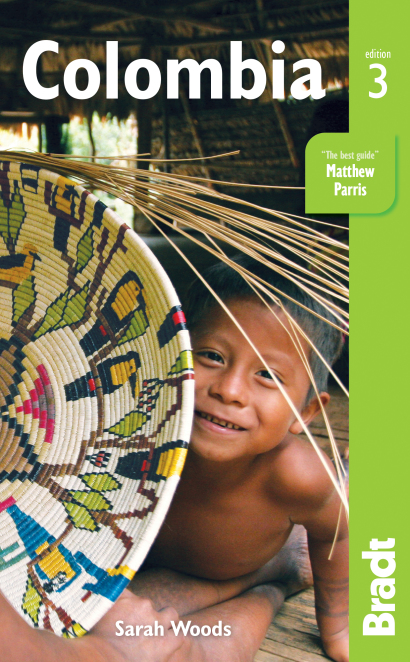

Food and drink in Colombia
In the last decade Colombia has experienced a gastronomic explosion, attracting world-class chefs to its thousands of restaurants to create a culinary scene that is one of Latin America’s best-kept secrets. Much of this modern gastronomic ID is found in Bogotá’s über-cosmopolitan restaurant districts, where Colombian Creole classics and champagne and oyster bars rub shoulders with pan-Asian fusion diners and stylish French brasseries. Yet Colombia’s sophisticated international culinary triumphs aren’t just confined to the swish bistros of the capital city. Mini-gastronomic circles are springing up in cities such as Cali and Medellín and the resort areas in Cartagena, creating an exciting alternative to Colombia’s traditional culinary staples. Yet, fear not – typical Colombian fare ( comida criolla ) remains very much in evidence on every street corner, from the sidewalk vendors selling paper-wrapped tamales to the hearty plates of chicken, rice, fried plantains and red beans served as comida corriente (set meal) in cantinas nationwide. Expect to find plenty of variations on comida criolla during a journey across Colombia, each with its own distinct twist. On the Caribbean coastline the focus is seafood, especially lobster, while in the Andes a guinea pig dish is a regional delicacy. In Bogotá, ajiaco (a stew of chicken and potatoes) promises to keep citydwellers warm during seasonal frosts, while generous helpings of sancocho soup are served using at least a hundred different recipes in every town from Leticia to El Cabo.
Vegetarian food
Colombia has a growing number of good vegetarian restaurants, although these are confined to the larger cities. Most are in Bogotá, Cali and Medellín, but there are a few surprises in Buenaventura, Meta and Barranquilla to name just a few. Juice bars, organic food shops, health stores and delicatessens are also found throughout the capital. Some of Colombia’s vegetarian diners feature on the international listing www.happycow.net . Entries also state if the menu is vegan, lacto, organic, eat-in or take-away.
Health and safety in Colombia
Healthcare in Colombia is reasonably good, especially in cities where getting modern medical treatment fairly fast poses little problem. In rural areas, however, don’t rely on finding any medical care. Arrive prepared with any medicines that might be needed and a first-aid kit, and plan for unforeseen emergencies. Health centres in most towns should be able to treat minor ailments and costs are usually very low. However, treatment is paid for at the time it is administered so it is important to have access to cash. Ask for a receipt if you intend to claim on your health insurance and be prepared to pay upfront if an ambulance is required. Medical staff in towns or rural areas may not speak English, so it may pay to look up some useful Spanish phrases beforehand, such as the names of allergies to medicines or words about pregnancy, etc. Take out health insurance before your visit to Colombia, and if you intend to trek or hike – a policy should cover every eventuality, including being evacuated for more advanced hospital care.
Although conflicting stories abound about safety in Colombia, the issue of travelling without incident here remains an important consideration. Those planning to criss-cross the country should do plenty of thorough research – whilst remaining mindful that Colombia thrives on urban myth and is prone to circulating safety information that is out of date. This country remains a place where there is danger, although the present security situation is much improved. Today, it offers the safest travel conditions for many decades and visitors who apply common sense should expect an incident-free stay. Take safety warnings extremely seriously and stay away from regions that are totally out of bounds. Red Zones under the control of warring factions are found in the south of the country, while some city slum areas are highly dangerous no-go areas where violence is rife.
Female travellers
Colombian women are highly politically active and appear extremely confident in social situations. However, machismo still plays a large role in Colombia and female travellers may feel less vulnerable in a group. Those travelling alone should be prepared for the occasional come-on, flirty comment and wolf-whistle from Colombian men – it is part of the culture and something that is best accepted with good grace. Expect it to happen wherever you are, be it a city or rural village – react without hostility but firmly ignore the attention. Avoid acting coy, shy or giggly as this may be misinterpreted as interest. Dressing in short skirts or revealing tops will only exacerbate the situation so stick to conservative clothing – even if the local girls are flaunting their bodies. Some travellers resort to wearing a wedding ring in order to put off male advances – it may work but will rarely stop a persistent suitor. Women who plan to party or drink in bars should remember that dancing with men or accepting drinks may also be construed as interest. Avoid drinking to excess as this will make you vulnerable and when leaving a bar or party make sure you are in a group. Never accept a lift, or walk home, with someone you don’t know, or have just met. Attacks on female tourists are rare with robbery a more common motivation than sex crimes. However, if anyone you don’t know approaches you on the street or on the beach, offering tours (or anything else) don’t wait to hear his patter – walk away.
Travellers with a disability
Colombia isn’t the easiest place for travellers with a disability, especially those keen to leave the major cities behind. Provincial roads tend to be unpaved, pot-holed and are often little more than dirt tracks. Although wheelchairs and mobility aids are available in large malls and shopping centres, they are rare in rural areas. Adaptations and amenities also vary from place to place. This inconsistency makes planning ahead difficult. However, Colombia’s National Institute for the Blind (Instituto Nacional para Ciegos, INCI) has made considerable inroads in campaigning for public information to be available in Braille. There are just over two million deaf people in Colombia, according to Federación Nacional de Sordos de Colombia, an organisation established to promote sign language (known as LSC) in 1984. Two constitutional laws for deaf people passed in 1996 recognise Colombian sign language and requires captioning or sign language on television.
Wheelchair ramps are also mandatory in new public buildings, although compliance is poor in this respect outside of urban centres. The Murillo Toro post office building in Bogotá has an entrance ramp, as does the Ministry of Education, but older buildings are rarely modified for disabled access and usually contain steep flights of steps. Much of Colombia’s public transportation system is also inaccessible, impairing the free movement of people with disabilities countrywide. The exception to this is the TransMilenio in Bogotá and Medellín’s Metro system, both of which have special facilities for disabled passengers and wheelchair users.
LGBTQ+ travellers
Colombia has a relatively small gay scene confined to its major cities but has witnessed significant improvements in gay and lesbian rights in recent years. However, discrimination remains rife, despite Colombia’s increasingly liberal social attitudes. Today, it may be easier to be openly homosexual in major cities but in rural areas the attitude towards gays and lesbians shows little sign of softening. Dozens of groups in Colombia have conducted anti-gay campaigns under such names as ‘Death to Homosexuals’. Even a human rights ombudsman once described homosexuals in a television interview as ‘abnormal faggots’ that should be subject to ‘social control’.
However, Colombia does have openly gay politicians, an active gay and lesbian information network and an active gay rights group – Bogotá-based Colombia Diversa, founded in 2004. Consensual homosexual activity was decriminalised in 1980 with amendments to the Criminal Code so there is a single age of consent of 14. In 2003, following strong opposition from the Catholic Church, an extremely progressive bill to give legal recognition to lesbian and gay partnerships was shelved. However, in February 2007 the Colombian Constitutional Court ruled that same-sex couples are entitled to the same inheritance rights as heterosexuals in common-law marriages. Even Colombia’s powerful Catholic hierarchy backed the bill on the basis that it didn’t include same-sex marriage or adoption. According to Colombia Diversa at least 100,000 couples will benefit from the new legislation, which is one of the most progressive gay rights reforms in Latin America. In 2010, gay rights advocates gathered in protest in Bogotá after Colombia’s Constitutional Court voted five to four to dismiss a lawsuit arguing for a change in the country’s civil code that would allow same-sex marriage.
Travel and visas in Colombia
Citizens from most western European countries (including the UK), Australia, New Zealand, the USA and Canada only need a valid passport to enter Colombia. A 30-, 60- or 90-day tourist visa will be issued on entry without the need to apply for any other visa in advance. Those planning to stay for up to 90 days should notify immigration officials as they tend to issue 30 or 60 days as standard.
Once in the country, extended stays of over 90 days should be arranged by visiting the Office of Immigration Affairs in Bogotá to submit an application. Those planning to work or study in Colombia will need to apply for the relevant visa from the Colombian consulate in their home country before they leave.
Citizens from restricted countries need to apply for a tourist visa in the Colombian consulate in their country of origin.
Whether arriving by plane or land, visitors must hold a return or onward ticket to prove an intention to leave the country. Furthermore, the ticket out of the country should be dated within 90 days to avoid difficulties at immigration. It is also entirely possible that proof may be required to show sufficient funds exist to cover your stay. Passport and visa requirements can change without much notice, so check with the Colombian embassy in advance of your trip.
Don’t forget to allow for the airport tax on departure, which is currently 71,000COP for a 90-day stay but less for a 60-day stay. Make sure your passport is stamped on both arrival and exit, whether you enter by air, land or sea, or you may be liable for a fine. Individuals entering or leaving Colombia are only entitled to carry up to US$10,000 in cash.
Anything in excess of this may be confiscated. Recently, a British national carrying US$14,000 had US$4,000 confiscated by the authorities at the airport, despite his argument that the money belonged to both him and his wife, who was travelling with him.
Those entering by sea must report to the port’s local immigration office for a passport entry stamp within one day of arrival.
Getting there and away
Colombia’s major international airports are El Dorado ( www.Bogota-dc.com/trans/aviones.htm ) in Bogotá (BOG), Alfonso Bonilla Aragón, Cali (CLO), José María Codova, Medellín (MDE), and Rafael Nuñez, Cartagena (CTG). Other popular international airports include Barranquilla (BAQ) and Bucaramanga (BGA). National airline Avianca ( www.avianca.com ) serves all international airports from most Latin American destinations as well as some cities in North America and Spain. The Avianca VIP lounge at El Dorado International Airport won the ‘Priority Pass Airport Lounge of the Year’ award in 2006.
Air France ( www.airfrance.co.uk ) operates from most western European destinations with stopovers on some routes. Iberia flies from Madrid to all the above airports, via Bogotá. American Airlines (www.aa.com), Northwest ( www.nwa.com ), Continental ( www.continentalairlines.com ) and Delta ( www.delta.com ) are the major airlines between the US and most of Colombia’s international airports. Copa (www.copaair.com) also provides services to New York, Miami and Orlando from Barranquilla, Bogotá and Cali.
From Bogotá, LAN Airlines ( www.lan.com ) connects to Miami, Quito, Ecuador and other South American destinations via stopovers. LACSA and TACA ( www.taca.com ) both connect between Bogotá and Latin American and some US destinations. Flying time is around 10½ hours from Madrid, 12 from Paris and 13 from London (exc stopover). Flying from New York takes 4½ hours and from Los Angeles 8 hours.
Most tourists entering by sea do so on cruise lines, where all necessary entrance formalities are taken care of by cruise staff. Several shipping companies dock on the Caribbean coast and it is possible to take a boat tour from both Colón and Kuna Yala (San Blas) in Panama to Colombia’s Cartagena. Those that do arrive in Cartagena by boat must visit the immigration office on the day of arrival for a Colombian entry stamp in their passport – fail to do so and you will be illegal in the country after 24 hours.
Getting around
Flying is by far the safest, easiest and most convenient way of getting around the country, with around 984 airports (although only around 100 have paved runways). Most domestic flights take less than 60 minutes’ flying time. Some offer business class and economy tickets and serve a snack and a drink. Avianca, Latin America’s first airline, Aires, AeroRepublica and Satena are some of the large domestic carriers, although there are others.
There are an estimated 18,000km of waterways in the country. Both the Río Magdalena (Magdalena River) that intersects the country to the north of Bogotá and the Río Cauca (Cauca River) are navigable in parts (some 1,500km). However, you should thoroughly research any such project first. Wide rivers and jungle canals sound intriguing, but they can lead you to some extremely remote destinations, which could be dangerous in the light of the current guerrilla and paramilitary situation. Jungle canals around Leticia provide a safer option, and tour operators can supply advice.
When to visit Colombia
Colombia lies almost entirely in the so-called Torrid Zone: a part of the earth’s surface between the tropics of Cancer and Capricorn characterised by hot weather. However, Colombia’s climate varies as a result of the differences in altitude with seasons defined by periods of lesser or greater rainfall, with little or no temperature change. Weatherwise, the country can be divided vertically into four regions with the hot country (tierra caliente) stretching from sea level to roughly 1,100m. In the temperate zone (tierra templada) elevations reach 3,000m while the remaining land is dubbed ‘the cold country’ (tierra fría) as it exceeds 3,000m. The cold zone’s upper area marks the treeline and roughly denotes the limit of human habitation. Adjacent to the tierra fría are Colombia’s treeless regions. These can reach 4,500m and are bleak areas referred to as the páramos, usually with permanent snow (nevado). Expect an average of 24–27°C in the hot low-lying regions along the Caribbean coastline and outlying islands, but don’t be surprised if they rarely exceed 22°C in lofty Bogotá. Medellín is known as ‘La Ciudad de la Eterna Primavera’ (or ‘City of the Eternal Spring’) throughout Colombia for its pleasant year-round climate with minimal temperature variations.
When to visit
Like many countries, Colombia is experiencing a blurring of the seasons and unpredictable and atypical weather patterns have flummoxed meteorologists in recent years. However, generally speaking, Colombia’s verano (summer) is from December to March. These months and those from mid-June to mid-August tend to be the best times to visit, with the exception of the northern plains where the wet season continues. Some 90% of Colombia’s territory is below 915m, tropical and warm with temperatures averaging around 25°C. The Caribbean coast and the Amazon are extremely humid and rain is sporadic and unpredictable even in the dry season. As you ascend Colombia’s Andes the temperature will drop around 6% per 1,000m. And, at an altitude of 1,980m, you’ll find yourself amongst glaciers, where temperatures can be as low as –17°C.
This range of climate and scenery is one of Colombia’s best assets and the country offers visitors the full spectrum of travel opportunities. Adventurous travellers can hop between the snow-capped peaks of the Colombian Andes and the Caribbean’s tropical turquoise waters and golden sands. Those looking for a more relaxed break can simply pick their preferred holiday – mountain hike, Caribbean beach, city jaunt or jungle trek are just some of the many, many choices available. High season in Colombia can be busy with hordes of domestic vacationers. Visit during the celebratory months of Carnaval (in Barranquilla, Feb/Mar), Semana Santa (Holy Week, Mar/Apr) or Navidad (Christmas) and plans should be made well in advance with hotels and transport booked. In addition, check for regional celebrations, when towns, villages and even roads close entirely to enable locals to enjoy the fiesta. Unless you dislike big or lively crowds, these regional and national festivals are a great way to become immersed in Colombia’s different cultures. Witness colourful rituals, dancing and the relaxed side of local life, as businesses close for the holiday and people revel in a party atmosphere that can last several days – at least.
What to see and do in Colombia
Exhilarating, humbling and awe-inspiring, the Amazon River is roughly the size of Germany, spanning 643,000km 2 and covering some 40% of South America as the largest lowland in Latin America. The river starts as a tiny trickle atop the snow-capped Andes Mountains and flows across the South American continent until it enters the Atlantic Ocean at Belém, Brazil. Reaching 40km in width at the height of the rainy season the mighty River Sea (as it is often referred to) can flood up to 350,000km 2 of land. Stretches of the River Amazon are deep enough to accommodate ocean liners. Sections are fast-flowing and debrisscattered fed by over 1,100 tributaries, 17 of which are more than 1,000 miles long.
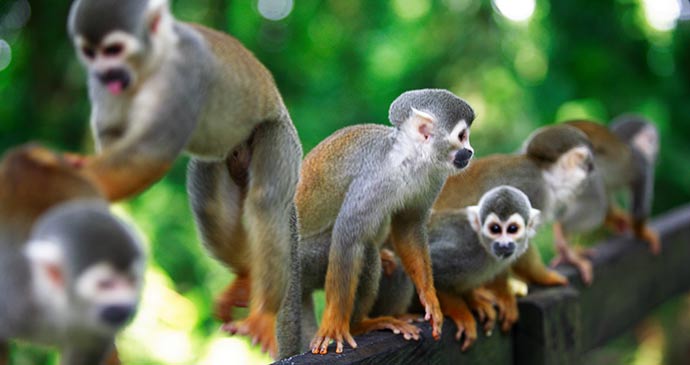
This mammoth watershed contains over two-thirds of the earth’s fresh water in its rivers, streams and tributaries. From the headwaters of Peru’s Ucayali-Apurímac river system the river flows for 6,400km to Brazil via Colombia, a distance slightly shorter than the Nile River but roughly the equivalent of a journey from New York City to Rome. Tiny wood-and-thatch Indian villages hug emerald vine-tangled riverbanks to the cacophony of squawking crimson parrots, chattering monkeys and whining insects in the treetops overhead. Piranha, crocodiles and dugout canoes navigate the waters of the mighty Amazon River and its many tributaries. Indian tribes hostile to strangers hide themselves away in the rainforest, living much as they did before the arrival of the Europeans, hunting, fishing and eating a diet of berries, plants and fruit. Giant blue butterflies and water lilies the size of serving trays are just a couple of the highlights in this magical, surreal land. Hot, sticky conditions complete with vast swarms of hungry mosquitoes and reddish glue-like mud prevail along this brooding river stretch of inky green.
As a region, the Amazon is home to at least 7,500 species of butterfly, 1,800 birds, 800 insect species and almost 2,000 species of reptile and amphibian. It contains 3,200 species of fish and is home to a staggering 10% of all species found on the planet. Botanists have recorded 51,220 species of plant, but doubt they will ever be able to catalogue everything in the lifetime of the world. In a single acre of forest, as many as 100 arboreal species have been counted. Up to 121 million litres of water per second are generated by the River Amazon with an average of three million tonnes of sediment deposited each day near its mouth. The annual outflow from the river accounts for 20% of all the fresh water draining into the entire world’s oceans.
Once a byword for danger, the city of Bogotá has undergone a significant clean-up act in recent years, following a passionate campaign aimed at nurturing societal change. Visionary leaderships have ignited fresh fire into the belly of Bogotá’s eight million inhabitants via a host of pioneering strategies that have helped change the mindset and behaviours of a once unruly urban sprawl. Today, Bogotá is a cosmopolitan city on the up, a metropolis that bears the signs of modern self-improvement.
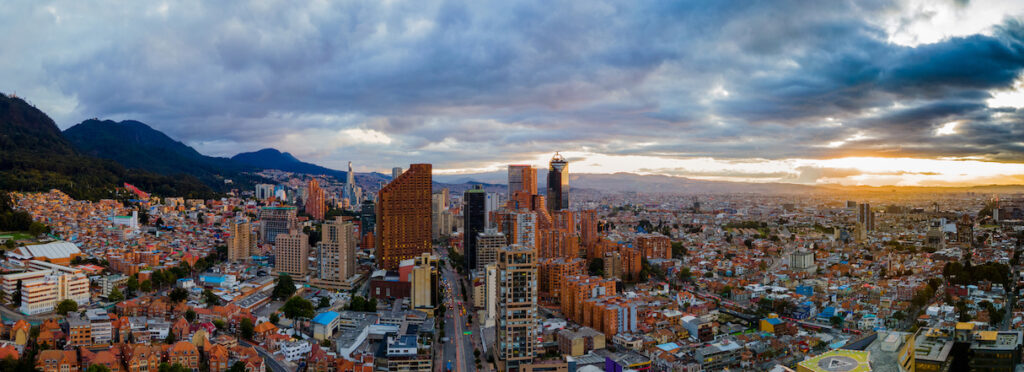
Sleek skyscrapers and a futuristic transit system are symbols of an (almost) transformed city that boasts 4,594 public parks. Thousands of cyclists of all ages criss-cross Bogotá’s wide, green expanses on Latin America’s largest bikepath network. Car use is restricted to lessen congestion. Vehicles no longer park on sidewalks and basic traffic laws such as stopping at a red light, giving priority to pedestrians, and buses stopping only at bus stops are largely obeyed (except perhaps by busetas). Citizenship is no longer a laughable concept in the city and today the mood is one of highly charged optimism. Designer stores, swanky cafés, lounge bars and fine restaurants are testament to Bogotá’s ambition to become one of the most desirable cities on the radar. Sunday in the city is a family day when the streets take on a party atmosphere of clowns, music and picnics in the parks. Food vendors, churchgoers and mothers with pushchairs converge on the plazas and compete for space with armies of pigeons. Jugglers take centre stage on empty roundabouts while old women on flower stalls sit amongst a fragrant kaleidoscope of varicoloured blooms. Paths are freshly swept and roads free of rubbish in a place where choking smog once dominated the cityscape. Today the people of Bogotá love and respect their city – it is now oh-so chévere (cool) to be Bogotano, a far cry from the sentiment of a decade ago when it was a place that was truly loathed.
Yet modern-day Bogotá still has its many problems, some of which are born out of a rapidly expanding refugee population displaced from Colombia’s rural provinces. Constant streams of migrants arrive in the capital full of high hopes, only to find the city’s streets aren’t paved with gold. Most of these poor peasants end up in the makeshift shanty towns that sprawl along Bogotá’s fast-decaying southern nub. Conditions are nothing short of horrendous with sanitation and fresh water scarce. Piles of rotting rubbish are scavenged for a glimmer of hope in sewageswamped streets that are as lawless as they are vile. Pickpockets plague the shopping malls and all sorts of evils roam the streets after dark yet, despite this, Colombia’s ‘first city’ refuses to be in the doldrums. Bogotanos are largely a morally responsive, socially conscious and fashionably introspective bunch – so the mood within vast swathes of the city is upbeat. Big hotels are also expressing confidence in Bogotá’s promising future – that Hilton returned to open a swanky US$27 million hotel in 2009 and Hyatt pledged US$100 million in 2010 is a clear show of faith. However, the vast disparities that exist between the affluent north and poverty-stricken south are nothing short of shocking – two very different faces of Bogotá, wrapped around the bubblegum-coloured colonial core of the old quarter of the city.
Caleños consider their passion for music and their beautiful women a source of great pride. Cali appears to be permeated by an irrepressible rhythmic pulse as Colombia’s undisputed ‘salsa city’. Every arterial in this modern urban sprawl seems to throb with a percussive Latin beat as Cali’s party people come out to play. Having imported salsa and other Latin American musical genres from Cuba and Puerto Rico, Caleños are rapturous about staccato merengue rhythms, samba and rumba classics and syncopated ta-tum-ta-tum bossa nova beats. Even on a weekday, hip-swaying salseros can be found sashaying and snaking through downtown arepa stalls bound for downtown salsotecas (salsa bars).
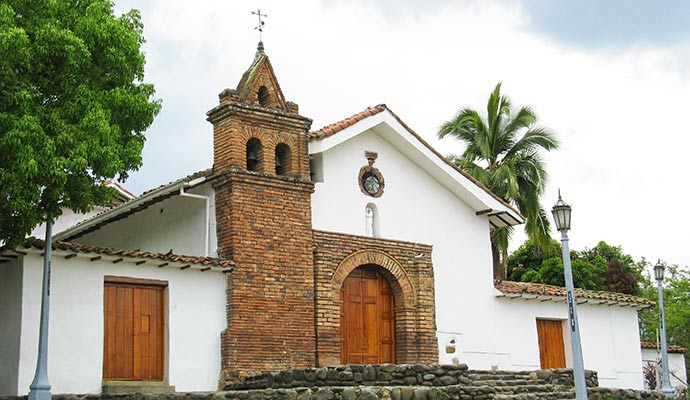
High-heeled women in skin-tight garb click their heels to the sound of drumming timbales and claves while car stereos emit the powerful boom of tumbao, cuica and cavaquinho. A row of neon-lit basement dancehalls emit a cocktail of pan-Latino melodies so sweet it can almost be imbibed. More than 130 salsa orchestras, 5,000 salsa students, dozens of music stores and instrument makers, over a hundred salsotecas and numerous conga, bongo and maracas players give Cali its character – along with an energetic nightlife that requires plenty of stamina. Cali is also home to a week-long salsa festival – the largest on the planet – that celebrated its 50th anniversary in 2007. This kaleidoscope of music and dance is not for the faint-hearted. Indeed, it’s as hot, claim the Caleños, as the women of the city and its year-round sultry heat.
Los Llanos – ‘the flat plains’ – is a vast grassland savanna that sprawls to the east of the Andes in northwest Colombia and Venezuela. These cattle-clad seasonally flooded lowlands cover over 50% of the country’s total landmass, comprising rolling grassy knolls, scrubby pasture and prairies dotted with ranches. The region’s main river is the Orinoco with gentle slopes that lead away from higher elevations, which barely rise above 200m. Herdsmen in Los Llanos raise mammoth droves of cattle over many thousands of acres with stud farms, horses and cow fields the lifeblood of Colombia’s ‘cowboy country’. Corralling, roping, ranging and lassoing are all-important skills in this rural hinterland where the nasal dialect of the Llaneros (plainspeople) remains peppered with phrases unchanged from the idioms of the first Spaniard settlers.
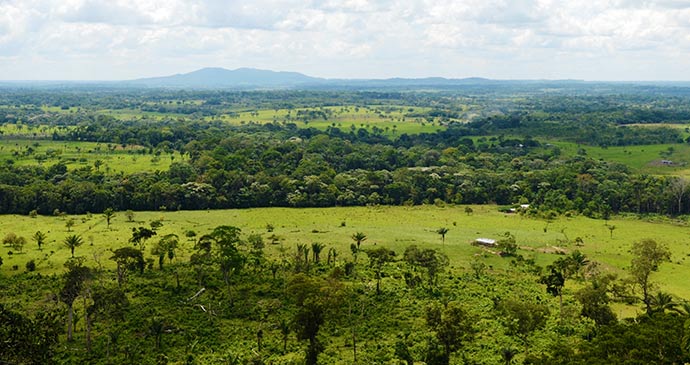
The Llaneros are proud of their hard lives and are dedicated cowboys from cradle to grave, spending long days enduring extreme heat and high winds in the saddle. Having learned how to ‘break’ horses while young, these gaucho-like ranchers enjoy a provincial culture rich in folklore, legends and stories. It is hard to image a Colombian song more poignant than those of Los Llanos’ heartfelt lilting lyrics to the melodic strum of the cuatro guitar or harp. A true Llanero is a legendary figure on the ranches of Colombia and these accomplished horsemen often wear the distinctive traditional working clothes of a poncho, straw hat and cotizas (rope-soled sandals).
Los Nevados National Park
Travellers keen to hike through some of Colombia’s most striking terrain will find this 583km² patch of the Andes fits the bill. Not only does this snow-caked range of volcanic peaks – topped by the 5,325m-tall Nevado del Ruiz – offer truly incredible views from trails that climb through cloudforest but it is also relatively easy to access and, most importantly, safe. However, it is very cold and the altitude can pose problems health-wise. On this basis, anyone not feeling 100% fit should give Los Nevados a miss.
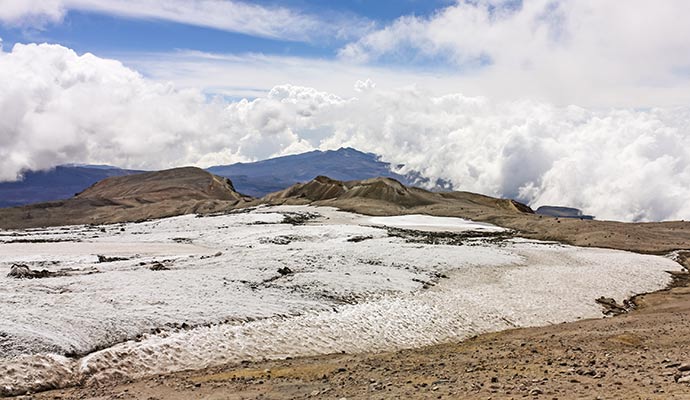
A hike to the summit of the still-active Nevado del Ruiz takes about three hours. Varying altitudes ensure a collection of well-maintained paths wind through considerable diverse terrains, from humid thickets and cool highland scrubland to crisp, white snow and ice. Popular with skiers and budding volcanologists, the range comprises El Tolima (5,215m) at the southern end followed by El Quindío (4,750m), Santa Isabel (4,950m), El Cisne (4,750m) and then El Ruiz in the north. The park attracts mountaineers from all over the world, many of whom traverse all four peaks. This takes about seven days to complete and is a highly popular challenge.
But it is not just the climbing that has made these mountains famous. On 13 November 1985 at precisely 21.08 Nevado del Ruiz erupted – with catastrophic results. Within four hours vast lava flows had travelled over 100km, leaving total devastation in their wake. More than 23,000 people were killed and more than 5,000 injured. The town of Armero (population 27,500) at the mouth of the Río Lagunillas canyon was hardest hit, disappearing entirely under the mud. Thousands of villagers along the Chinchiná, Gualí and Lagunillas rivers fled in fear as their homes surrendered to the lahars.
San Andrés Archipelago
Colombia’s only oceanic department – the West Indies department – is one of the most isolated island regions in the Americas, located 800km northeast of the Colombian mainland, just 150km from the Nicaraguan coast. Laid-back locals pride themselves on being barefoot champions of leisure in a calypso culture that is a world away from fast-paced Bogotá. Warm Caribbean waters are home to a cluster of palm-scattered atolls, islets and cays in an archipelago where 300,000km 2 forms the main constituent of a UNESCO Seaflower Biosphere Reserve (Reserva de la Biosfera Seaflower). Fertile waters, grass beds and mangrove-clad lagoons host a magnificent array of bird species with isolated soft-sand beaches and undisturbed coral reefs rich in underwater flora and fauna.
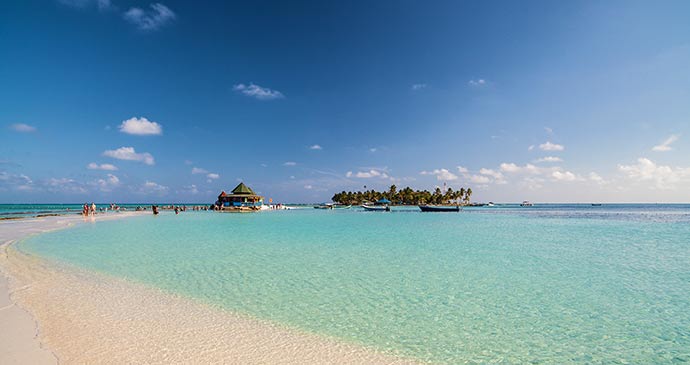
Three inhabited islands form the archipelago’s geographical and spiritual heart, as immortalised in the lyrics of Colombian musician Francisco Zumaque’s catchy chart-topper ‘San Andrés’. Around them lie five uninhabited atolls to the north and two to the south with a liberal scattering of sandbanks and cays in between, including the submerged islet of Alicia Shoal.
Related books
For more information, see our guide to Colombia :
Related articles
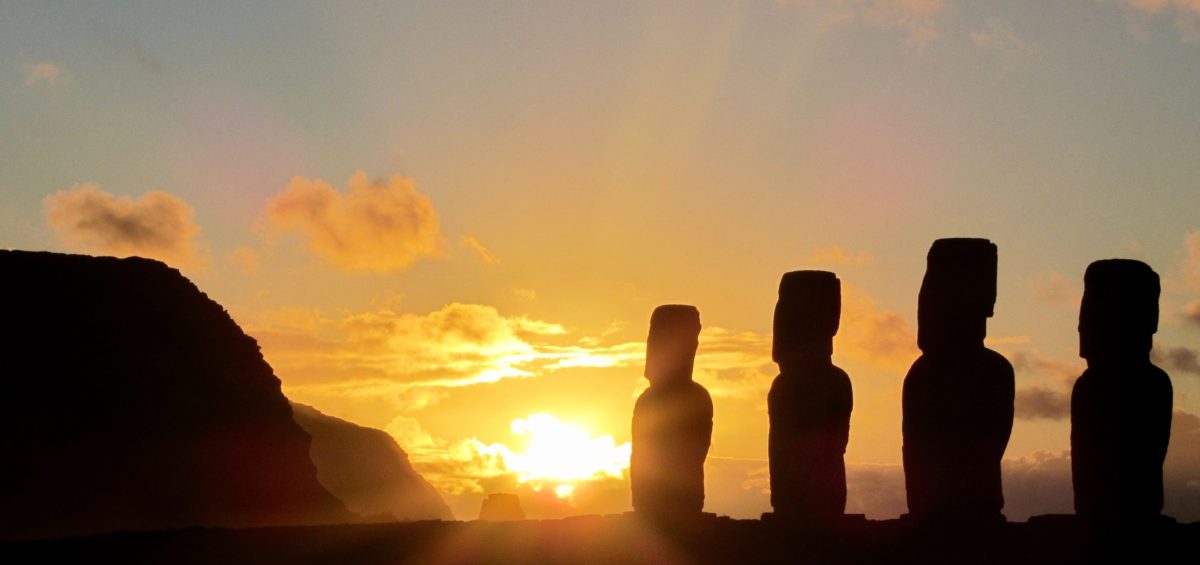
9 lost cities of the world
From crumbling Persian empires to colossal Roman cities, here are some of our favourite ruined civilisations from around the world.

Brighten up your day with the world’s most colourful places
Sit back and enjoy this kaleidoscope of colours.
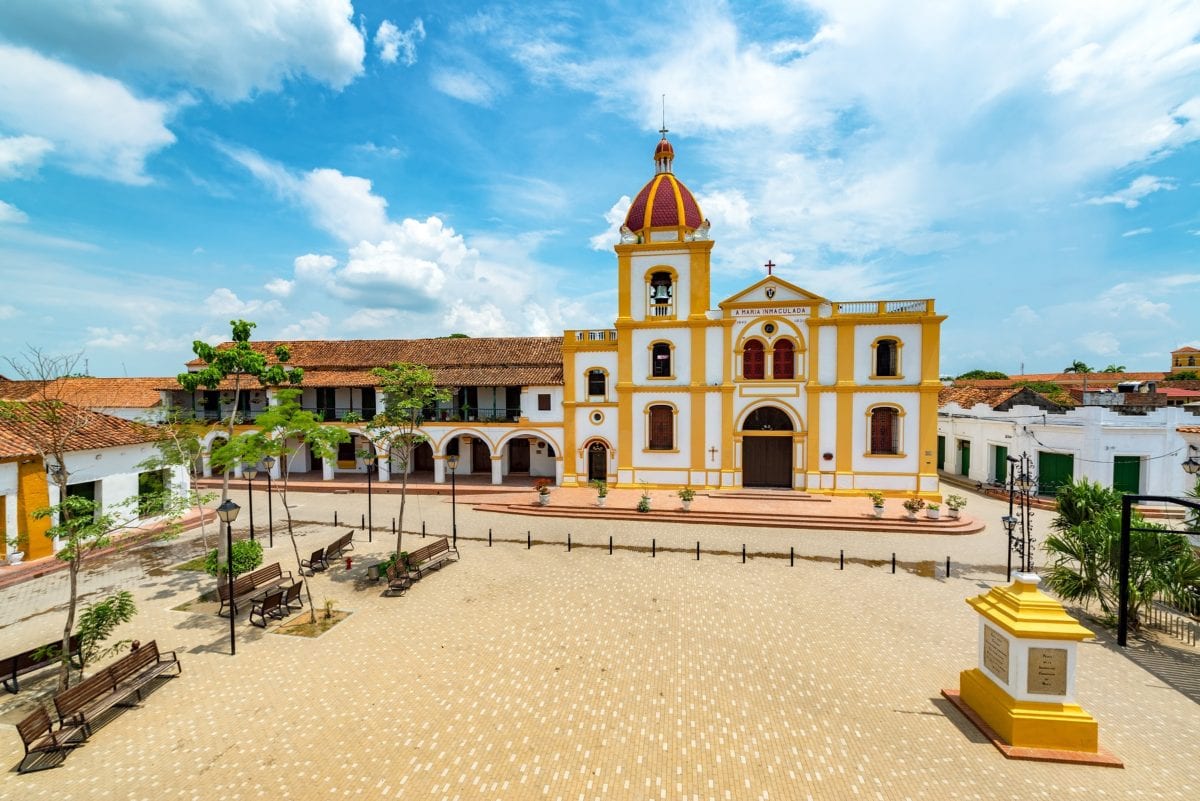
García Márquez, The Liberator and me: a journey to Mompox
Ben Box travels around Colombia to explore the impact of the landscape on García Márquez’s works and relationships
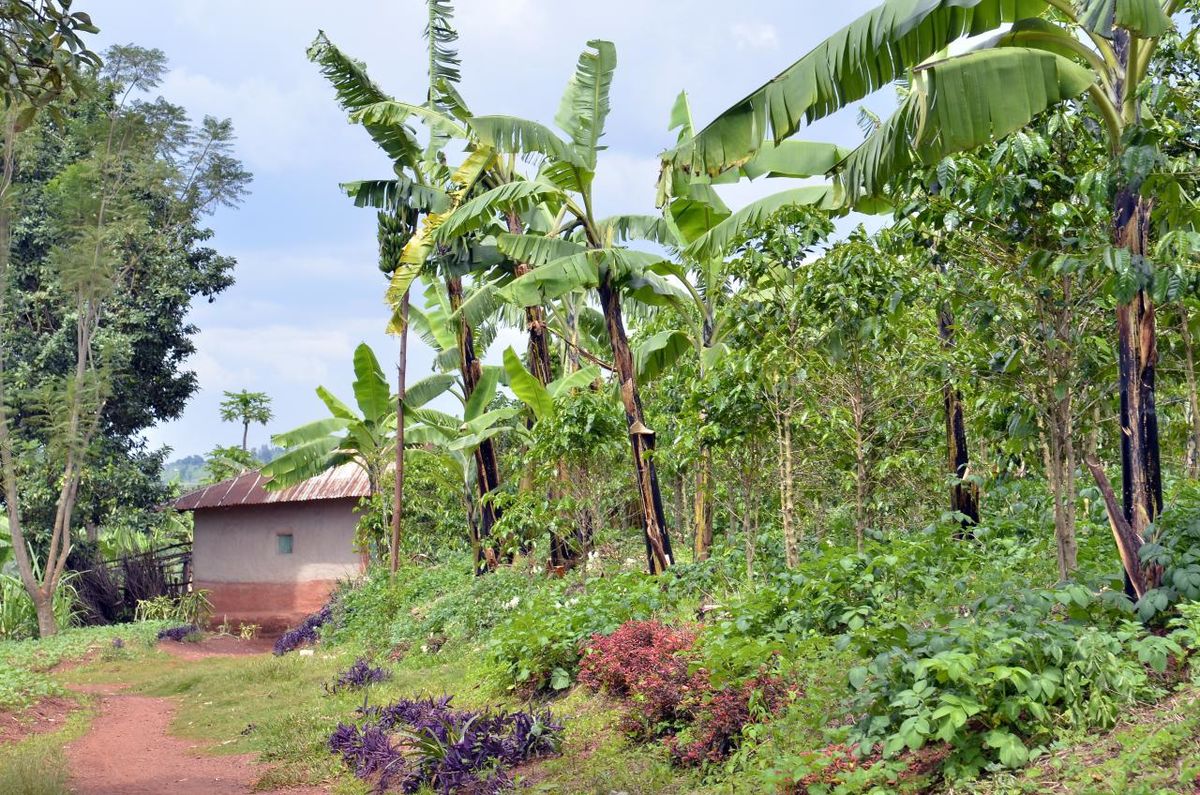
The best coffee destinations around the world
From Colombia to Kosovo, we pick some of our favourite lesser-known places to enjoy a good cup of coffee.
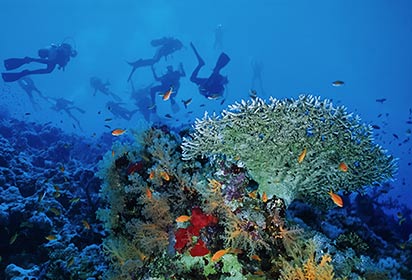
Unusual dive sites
We’ve all heard of the Great Barrier Reef, but what about these more unknown dive sites?
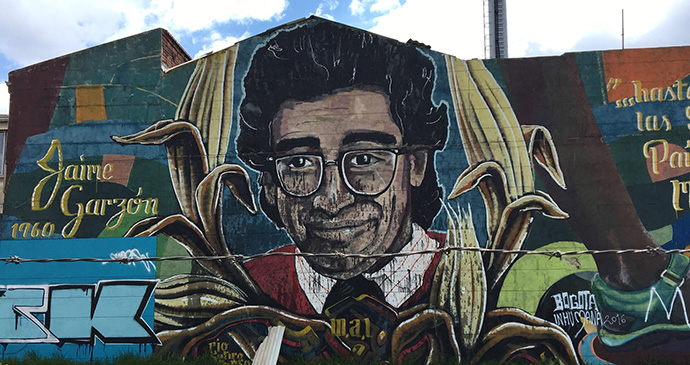
My Daughter’s Laugh
Winner of Bradt’s New Travel Writer of the Year competition 2016, tells the story of his first trip away from his daughter.

Complete Colombia Travel Guide, What You Need to Know
Explore Colombia with this expert Colombia travel guide. Colombia was rated the happiest place in the world in 2013 and 2014. The country is best known for its Andes mountains, Amazon rainforest, and the warm Caribbean coast. You will also find coffee plantations, amazing beaches, world-class salsa dancing, and colorful old towns.
Colombia receives over 4.5 million tourists each year. Planning international travel can be overwhelming and time-consuming while working full-time. Use this Colombia travel guide and the following Colombia travel blog post to plan your perfect vacation. The top destinations in Colombia are Cartagena, Medellin, and Bogotá.
Hint: Book a pre or post stopover in Panama City when you fly on Copa Airlines

Top Destinations in Colombia
Why visit cartagena.
Cartagena is a popular tourist spot located on the Caribbean coastline. It is one of the most popular cities in Colombia and is well known for its old city wall and colorful colonial homes.
READ Things to Do in Cartagena Colombia, One Week Itinerary

Why Visit Medellin
Medellin is located in the coffee region of the Andes Mountains. It is the second biggest and most populous city in Colombia. Medellin is well known for its arts, culture, friendly people and festivals.

Why Visit Bogotá
Bogotá, the capital and largest city in Colombia, sits high in the Andes Mountains. The city has a colorful old town and is well known for its street art. The Sanctuary of Monserrate is one of the top attractions in Bogotá and not to be missed.

What You Need to Know When Planning a Trip to Colombia
Where is colombia.
Colombia is in Northern South America, it is bordered by the Caribbean Sea, between Panama and Venezuela, and the North Pacific Ocean, between Ecuador and Panama. With 441,000 square miles of land, Colombia is about the combined size of France and Spain. It is the fourth largest country in South America.
What is the language spoken in Colombia?
The national language of Colombia is Spanish with over 11 dialects. Less than 10% of the Colombian population speaks English, it is spoken in Bogota, San Andres Islands, and Cartagena. It is important to at least try to speak the common language before resorting to English. FluentU offers a helpful list of common words and phrases to learn before you travel. You will also find tutorials on YouTube.

Do I need a visa to visit Colombia?
According to Project Visa , US citizens do not need a visa for a visit up to 90 days. You must have a passport valid for at least six months beyond your date of country exit and with one blank visa page. Additionally, you must show forward passage to the next destination in the form of booked seats on a flight, boat, or bus. Note: the US recommends Yellow Fever vaccinations for entry into Colombia.
What is the currency in Colombia?
The currency in Colombia is the Colombian Peso (COP). Prices in Colombia are marked with a dollar sign, do not get confused, the price is in pesos. Denominations include 50, 100, 200, 500 and 1,000 peso coins and 1,000, 2,000, 5,000, 10,000, 20,000, 50,000 and 100,000 peso banknotes. US dollars are not accepted at restaurants, attractions, or stores. Don’t be fooled by ‘0 commission’ money exchangers because the ‘service fee’ is high. Be sure to download a free currency calculator before you arrive.

Can I use credit cards and ATMs in Colombia?
ATMs are available in urban areas, but they are hard to find in rural areas. It’s best to carry smaller bills with you as it can be hard to get change. It’s best to use ATM machines located inside a building, as these offer more security. Avoid large fees by using your bank’s international partner in Colombia and google its location before you travel.
Visa and Mastercard are widely accepted in urban areas, you will need a 4-digit PIN from the bank. American Express and Diners Club may be accepted. Remember to notify your bank that you will be traveling to Colombia. Save money on fees with a credit card that waives foreign transaction fees and makes purchases in pesos. It is always a good idea to carry some cash.
How much should I budget per day in Colombia?
According to Budget Your Trip , the average daily cost of traveling in Colombia is $ $44 (CO$176,533). Expect to pay $ 620 + airfare for a one-week trip for 2. This includes accommodation, food, local transportation, and sightseeing.

When is the best time to visit Colombia?
Colombia experiences consistently warm temperatures throughout the year depending upon your altitude. Expect temperatures between 75-90 degrees. December to March to the dry season in Colombia. This is also high season, expect high prices and crowds. April – June and August – October see the most rainfall. Expect high altitudes to be chilly at night.
What type of transportation is available in Colombia?
Colombia does not have a train system. Buses are the main mode of transport in Colombia. Most towns have a central bus station with large buses departing to destinations across the country. A colectivo is a small privately owned van that transports people to various places. They do not have a set route and drive around tourist areas yelling out their destination until the van is full. Expect to pay cash and always allow plenty of time when taking a colectivo.
Flights are often less expensive than buses. Colombia is a large country with many airports. Domestic airlines offer affordable flights that save time and energy. For example, driving from Bogotá to Medellín takes about 9 hours while flying takes only 1 hour.
Taxi is the most convenient and most expensive means of travel. Most do not have working meters, negotiate the price beforehand. Uber is illegal in Colombia. Public transportation buses have set routes but not set stops. Wave the bus down and tell them your destination when you enter; you will be charged based on distance.
Driving is not recommended in Colombia. Car rental and gas in Colombia is expensive. You will need a valid international driver’s license and insurance is mandatory. Colombians drive on the right side of the road. Colombia does not have a solid infrastructure and roads are not maintained. As a result, you will face head-on collisions with fast drivers and trucks and buses speeding past you on single-lane roads curved atop mountains. Check out this YouTube of a driver’s dash cam before renting a car if you believe you are an expert driver and can handle it.

What kind of adaptor do I need in Colombia?
Colombia uses plugs and voltage that are compatible with US devices: Type A (2 prongs, flat pins), Type B (3 prongs, 2 flat pins, 1 round pin) and the standard voltage is 110 V. You will not need a converter if coming from the US, regardless, I recommend bringing a universal adapter with surge protection. The last thing to worry about on vacation is if your phone will blow up while charging it.
What should I pack for Colombia?
Colombia’s environment is varied. Cartegena is a tropical environment; pack light-colored and lightweight clothing. Comfortable walking shoes for cobblestoned Old Town Cartagena. Beach items include a swimsuit, coverup, water shoes, dry bag, sunscreen, and aloe vera. Sea Bands to combat motion sickness on boats or while traveling winding roads. Whatever region you will be traveling pack: Insect repellant (at least 20% DEET), a rain jacket and umbrella, and Imodium (traveler’s diarrhea is common). You will need a jacket in the evening in Medellín, Bogotá, and the other Andean cities are cold and the Amazon is hot and humid.

Is Colombia a safe country for solo travelers?
The Travel Ladies App has ranked Colombia #57 safest country for solo female travelers. Sex tourism is a problem in Colombia. Women are known to drug men and rob them during the night.
According to Travel Safe Abroad , the risk of traveling to Cartegena is low. However, there is a risk of mugging. Do not wear flashy jewelry or show expensive electronics. Stay aware of your surroundings. As a foreigner you are a target, don’t make it easy. Be cautious at bars, drinks may be drugged resulting in mugging or sexual assault. The overall risk of travel to Bogotá or Medellin is medium. The overall risk of travel to Cali is high. Due to civil unrest, Barranquilla is currently on the US Level 4 do not travel list.
Dial 123 in an emergency. Contact the US Embassy in Bogota for non-urgent emergencies, such as a lost passport.
What food do I need to try in Colombia?
Bandeja paisa (platter of meats, fried egg, white rice, corn, plantain, red beans, and avocado), empanadas, tamales, ceviche, arepas (cornmeal pancakes with cheese, fried eggs or meat), pane del buono (cheese bread), bunuelos (deep fried balls with cheese), carimanolas (fritters stuffed with ground beef or shredded chicken and cheese), granadillas (sweet passion fruit), obleas (two wafer cookies with filling in between), Colombian hot chocolate, Colombian coffee, and aguardiente (national liquor of Colombia).

Colombia Travel Guide Tips
- Look both ways several times before crossing the street, you don’t have the right of way (no one does).
- It is common the see military in the streets in large cities.
- Most buildings have security and barbed wire.
- Driving apps (Uber) are illegal but still used. Expect to be asked to sit in front and remember the driver’s name.
- The M or D on a bathroom door stands for Mujeres or Dames (women) and the H or C on the bathroom door stands for Hombres or Caballeros (men).
- Do not talk about the show NARCOS, Pablo Escobar, or cocaine, it’s offensive.
- Only drink bottled water or bottled beverages in Colombia and avoid ice.
- Taxi drivers don’t understand Google Maps, give them an address.
- Things move slowly, be patient.
- Tell pushy vendors “no, I don’t have cash” firmly.

Top 10 Things to See and Do in Colombia
- Explore the historic walled city of Cartegena
- Go island hopping in the Rosario Islands
- Snorkel in Tayrona National Natural Park
- Spend a few days in Leticia and the Amazon rainforest
- See the colors of the Cano Cristales River, the “Liquid Rainbow”
- Take the 4-day Lost City Trek
- Explore Barichara, named the prettiest town in Colombia
- Visit a coffee plantation in Salento, Jardin, or Minca
- Attend Carnival in Barranquilla
- Learn to salsa dance in Cali
Be sure to check the Colombia Board of Tourism for upcoming festivals, special events, and what’s happening during your stay.
Colombia Travel Guide Interesting Facts
- Colombia is named after Christopher Columbus.
- The equator passes through the southern tip of the country.
- Colombia is the only country in South America that has coastlines on both the Pacific Ocean and the Caribbean Sea.
- Bogota is one of the most elevated cities in the world.
- The Lost City Is older than Machu Pichu.
- The legend of El Dorado, the city of gold, is said to be in Colombia’s Andes Mountains.
- One-third of Colombia Is the Amazon Rainforest and there are pink dolphins in it.
- Wax Palms, the world’s tallest palm trees, grow in Columbia’s Cocora Valley.
- Colombia has 60 National Parks, one of which is over 4.3 million hectares.
- 70% of the flowers imported to the United States are from Colombia.
- There are 18 national holidays a year in Colombia.
- By law, the national anthem is played at 6am and 6 pm on all public broadcast stations.
- Tejo is the national sport of Columbia, and it involves gunpowder.
- Colombia has the world’s largest salsa festival, Feria de Cali.
- 70-90% of the world’s emeralds come from Colombia.
- Colombia is the third largest coffee producer in the world.
- Colombia has over 30 different kinds of exotic fruits.
- Age is valued in Colombia and elders are respected.
- There are 80 indigenous nations and 88 languages spoken in Colombia.
Bookmark and Pin Complete Colombia Travel Guide, What You Need to Know

Booking Resources for Colombia
Colombia travel guide books.
Pick up a Colombia Travel Guide from Amazon.com to browse on the plane.
Book Your Accommodation in Colombia Now
Spending the night? Search Booking.com and VRBO in one place to find the perfect property!
Colombia Attractions and Day Tours
The best attractions sell out! Don’t chance it, get your tickets now and relax when you arrive.
Travel Essentials
Need a universal travel adaptor, power bank charger, or packing cubes? Save time at my Amazon shop and have travel essentials delivered to your home.
Have a great vacation!
- Travel Advisories |
- Contact Us |
- MyTravelGov |
Find U.S. Embassies & Consulates
Travel.state.gov, congressional liaison, special issuance agency, u.s. passports, international travel, intercountry adoption, international parental child abduction, records and authentications, popular links, travel advisories, mytravelgov, stay connected, legal resources, legal information, info for u.s. law enforcement, replace or certify documents.
Share this page:
Colombia Travel Advisory
Travel advisory january 2, 2024, colombia - level 3: reconsider travel.
Reissued with updates to the country summary.
Reconsider travel due to crime and terrorism . Exercise increased caution due to civil unrest and kidnapping . Some areas have increased risk. Read the entire Travel Advisory.
Do Not Travel to:
- Arauca, Cauca (excluding Popayán), and Norte de Santander departments due to crime and terrorism.
- The Colombia-Venezuela border region due to crime, kidnapping, and risk of detention when crossing into Venezuela from Colombia.
Country Summary: Violent crime, such as homicide, assault, and armed robbery, is widespread. Organized criminal activities, such as extortion, robbery, and kidnapping, are common in some areas.
Terrorist groups and criminal organizations continue operating and carrying out attacks in Colombia. They may attack with little or no warning, targeting transportation hubs, markets/shopping malls, local government facilities, police stations, military facilities, hotels, clubs, restaurants, airports, other public areas, and U.S. government facilities.
Demonstrations occur regularly throughout the country and can be about a variety of political or economic issues. They can shutdown roads and highways, often without prior notice or estimated reopening timelines. Demonstrations and road closures may significantly reduce access to public transportation and may disrupt travel within and between cities. Protests can become violent and can result in fatalities and injuries.
U.S. direct-hire government employees must adhere to the noted restrictions:
- They are not permitted to travel by road between most cities.
- Colombia’s land border areas are off-limits to U.S. government personnel unless specifically authorized.
- They may not use motorcycles.
- They may not hail street taxis or use public buses.
Read the country information page for additional information on travel to Colombia.
If you decide to travel to Colombia:
- Avoid protest areas and crowds.
- Monitor local media for breaking events and adjust your plans based on new information.
- Keep a low profile.
- Be aware of your surroundings.
- Enroll in the Smart Traveler Enrollment Program (STEP) to receive Alerts and make it easier to locate you in an emergency.
- Follow the Department of State on Facebook and Twitter
- Review the Country Security Report for Colombia.
- Prepare a contingency plan for emergency situations. Review the Traveler’s Checklist .
Arauca, Cauca, and Norte de Santander Departments – Level 4: Do Not Travel
Violent crime, including armed robbery and homicide, is widespread. Terrorist groups are active in some parts.
The U.S. government has limited ability to provide emergency services to U.S. citizens as U.S. government-personnel travel to these areas is severely restricted due to security concerns.
Colombia - Venezuela Border – Level 4: Do Not Travel
U.S. citizens are advised not to travel to the border of Colombia and Venezuela. U.S. citizens are at risk of detention when crossing into Venezuela.
The Colombia-Venezuela border is not clearly marked, and U.S. citizens should not go near the border due to the risk of crossing into Venezuela accidentally.
U.S. citizens attempting to enter Venezuela without a visa have been charged with terrorism and other serious crimes and detained for long periods. For more information, see the Venezuela Travel Advisory.
Visit our website for Travel to High-Risk Areas .
Travel Advisory Levels
Assistance for u.s. citizens, colombia map, search travel advisories, external link.
You are about to leave travel.state.gov for an external website that is not maintained by the U.S. Department of State.
Links to external websites are provided as a convenience and should not be construed as an endorsement by the U.S. Department of State of the views or products contained therein. If you wish to remain on travel.state.gov, click the "cancel" message.
You are about to visit:

13 Important Tips For First-Timers Visiting Colombia
- Eat at the hotel for cleanliness and safety.
- Bring enough cash for daily activities, especially in remote areas.
- Learn basic Spanish to navigate the country and communicate effectively.
Visiting Colombia for the first time can be exciting, but just like any destination worldwide, there are some tips one needs to know before visiting. Language, weather, money, and transportation can be quite confusing, especially in Colombia. Still, with these tips, one will be able to avoid a lot of difficult situations in the country. It doesn't matter if you're here for ten days or three; Colombia is a gorgeous country with endless things to experience. Whether it's someone's first time or they need a refresher, you can't go wrong with following these essential tips for traveling to beautiful Colombia!
UPDATE: 2023/11/25 16:36 EST BY NOAH STAATS
There Are More Things To Know When Visiting Colombia
This article has been refreshed with new information regarding a trip to beautiful Colombia, as well as expanded talking points for previous suggestions. Remember to stay out of bad neighborhoods at night, bring enough cash for day trips, learn some Spanish, and have plenty of fun!
Eat At The Hotel If You're Worried About Cleanliness
For those coming to Colombia and nervous about food and water cleanliness, it's always a safe bet to eat with your hotel or resort and get water via gift shops inside them. Although most places in bigger Colombian cities are clean and safe, some smaller villages do not abide by strict health and sanitation regulations when preparing or serving food and drinks. To steer clear of food-borne illness, make sure and book restaurants with good reviews and clean kitchens/dining rooms.
- It's generally better to eat at the hotel if you're staying somewhere off the beaten path.
Tayrona National Park is a fun day trip idea for visitors to Colombia.
Make Sure And Keep Some Cash Ready
One thing many visitors to Colombia forget is to bring enough cash for daily activities. Because debit and credit cards are often not accepted or take a large conversion fee, getting cash from the bank or at your hotel may be the better option. Of course, in bigger cities, there will be more accessibility and availability to ATMs and stores taking credit cards, but in remote towns and villages: bring cash.
That said, keep all cash somewhere safe and hard to get to. Pickpocketing is prevalent here, as well as violent assault in poorer areas.
- Because of steep ATM and credit card fees, it's best to bring enough money for everyday food, attractions, and transportation when visiting Colombia.
Learn Some Spanish Words
Colombia is a place where the majority of the population speaks only Spanish. In a place like Bogotá - the capital city , most people only speak Spanish, which means it can be difficult to get around if one only knows English. While one does not necessarily need to know how to speak the language, some basic words will go a long way and help one better get around the country.
- Learning basic Spanish will go a long way when coming to Colombia.
Taxis Are Cheap, But Buses Are Cheaper And Safer
Buses are Colombia's main means of transportation, and they are incredibly cheap and safe. Taxis, on the other hand, are also cheap, but a few inconveniences come with them. First, they can be unsafe, as fake taxi drivers can rob passengers. Apps such as Uber and Easy Taxi are illegal in the country, but they are still in operation and are the safest ways to get taxis.
- Taking the bus is often cheaper and safer than taxis while in Colombia.
Avoid Lonely Areas, Especially At Night
Just like many other amazing destinations worldwide, Colombia experiences increased crime, which is why one must exercise extreme caution when visiting. A good rule is avoiding lonely areas, especially at night. For the first trip, travelers can stick to the popular tourist destinations around the country, which are usually more crowded, to avoid being an easy target.
- Tourists to Colombia are not recommended to venture out into lonely/quiet areas at night.
Avoid Unnecessary Display Of Wealth
Showing unnecessary displays of wealth, especially in a country like Colombia, may be dangerous. The country's economy is bad, which has made many people living there desperate. It is advisable to avoid putting on too many accessories or carrying large amounts of money around to avoid drawing too much attention to oneself.
- Wearing fancy clothes, jewelry, or other accessories in Colombia can get you into trouble at night or in certain areas.
Prepare An Itinerary To Follow Before Visiting
Colombia is very big and endowed with plenty of natural and man-made attractions, which means there are plenty of things to see and do here. Without a proper itinerary of what to do in the country, one can find it difficult to get the most out of their visit. During the planning process, make a list of things to do in the country and follow that itinerary when in the country. There will be more to do, but it is better to have a plan rather than randomly deciding what to do.
- Planning before you come here can help ease frustration due to Colombia's vast offerings.
Related: 10 Best Places To Visit In Colombia
The Weather Can Be Unpredictable, So Come Prepared
Colombia experiences two major seasons, which are rainy and dry. But the weather is not usually not dependent on the time of the year but on elevation. The weather can easily change from sunny to rainy in some parts of the country with higher elevations, like Bogotá. The temperature is also known to sometimes rise from as low as 4 degrees Celsius to 19 degrees Celsius on some days. Some parts of the country, such as Cartagena and Santa Marta, experience lots of sunshine all year round. This means at any time of the year; one can experience all four seasons in Colombia. With such diverse and unpredictable weather, one has to come prepared to face any type of weather in this country.
- The weather is unpredictable in Colombia, with wild changes in temperature being common.
Never Talk About Drugs, Especially Cocaine
One important thing to always avoid doing in Colombia is talking about drugs. Drug production and trafficking continue to increase in this country, and drug is always accompanied by crime. This makes it not just a national issue but a global issue for which Colombia plays a major role as it is one of the major producers of cocaine in the world. In 2021, the production of coca leaves which is the main ingredient for cocaine, increased drastically. To avoid getting into a difficult situation, pretend not to know anything about drugs in Colombia and instead focus on enjoying the amazing things the country has to offer.
- Joking or discussing cocaine can and will get you in trouble with law enforcement in Colombia.
Haggle Before Buying Something
The asking price of a product in Colombia may not always be the actual price but just the seller trying to get more profit from tourists who may not know the price. To avoid getting ripped by sellers (who always know a gringo when they see one), employ the skill of bargaining when purchasing something. Buying something $5 less than the initial asking price is not uncommon.
- It's worth it to try and bargain with vendors while shopping in Colombia.
Altitude Sickness Is Real In Colombia
In Colombia, like many parts of South America, high altitude is something that one often has to worry about as the country is filled with many mountains. Bogota, the country’s capital, rises to an elevation of 8,660 feet , making it one of the highest cities in the world. One important tip to help deal with altitude sickness in Colombia is to always stay hydrated when heading to places with high altitudes. Adventurers seeking to go rock climbing or visit higher places can also include other substances like vitamins and minerals to cushion the effects of the high altitudes. Alcohol, caffeine, and other dehydrating substances should also be avoided when heading to higher elevations.
- Because of the possible 8,660 feet of elevation in Colombia, it's not uncommon for altitude sickness to ravage through groups vacationing to the country.
Related: Tips To Avoid The Altitude Sickness While Traveling In South America
It’s Not Mandatory To Tip
In hotels, bars, restaurants, and other service centers around Colombia, tipping is not usually mandatory or expected, unlike in other countries. Nicer restaurants usually include a 10% service charge automatically on the bill. Of course, if the service was exceptional, it does not hurt to give the service person some extra change. Tipping taxi drivers is also not a thing as passengers are only required to pay the amount on the meter; still, the extra tip is always appreciated. In most cases, tips cost between 2,000 and 5,000 Columbian Pesos, equivalent to a dollar. That's like nothing to most tourists, but the locals in Colombia appreciate it so much.
- Adding a tip (although appreciated) is not required in Colombia.
Be Careful On The Roads
The traffic in Colombia can be chaotic. Drivers here are usually impatient and aggressive and won’t stop for anybody. To avoid getting into a dangerous situation on the road, it is important to be careful on the roads. With dangerous roads and long traffic jams, it will be better to avoid driving in Colombia and just stick to using taxis and buses.
- Driving can be difficult here, especially regarding other impatient and volatile drivers.
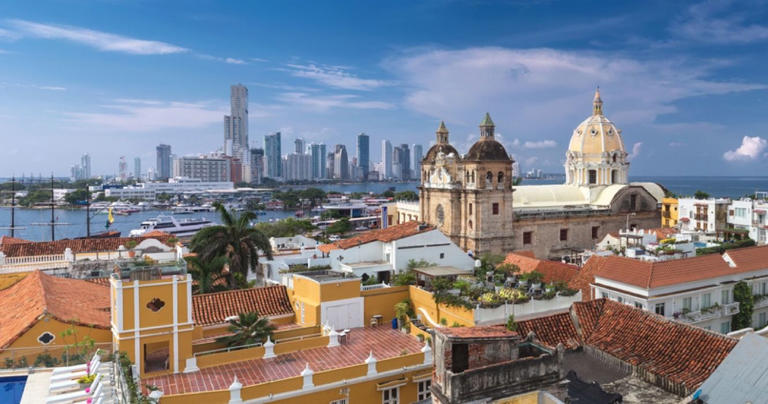
Every country has its own card offerings. Search for your country to see what cards are available in your area. You’ll be taken to the website for your local Club to apply.
No cards currently available in that location
SELECT YOUR COUNTRY
To find out more about your account or see what your local Club has to offer, choose your country. You’ll be taken to the website for your local Diners Club.
No local Club currently in that location
Find your Local Offers
No local Offer currently in that location
Welcome to Diners Club International ®

Together Belong
Belonging is not where we are, it’s how we feel when we’re there together. That’s the power of the Club.
Whether across the world or around the corner, Diners Club offers benefits to help you on your journey. Join the Club and experience the everyday and the unforgettable with us.
Spend Together
All countries and cultures are unique, so we offer cards tailored to the needs of every market. Visit the website of your local Diners Club to see what’s available in your area. No matter which card you pick, you’ll enjoy all the worldwide benefits of being a Clubmember.

Experience Together
Live life to the fullest with distinctive benefits for Clubmembers.
- Privileges and offers to enhance your shopping, dining, travel and hotel stays
- Access to airport lounges and car rental offers
- Get travel inspiration for your next trip
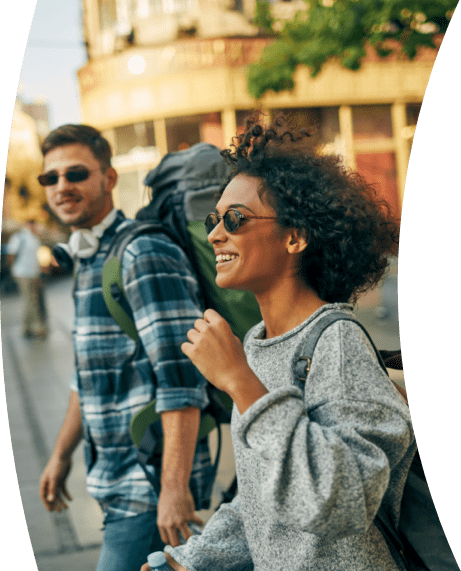
Accepted Together
Discover a world of opportunity with acceptance at more than 55 million merchants 1 across 200+ countries and territories 2 .
1 Based on data provided to Diners Club International by merchants, acquiring institutions and other third parties as of December 31, 2023.
2 Based on transaction data collected from 2019 through 2023.
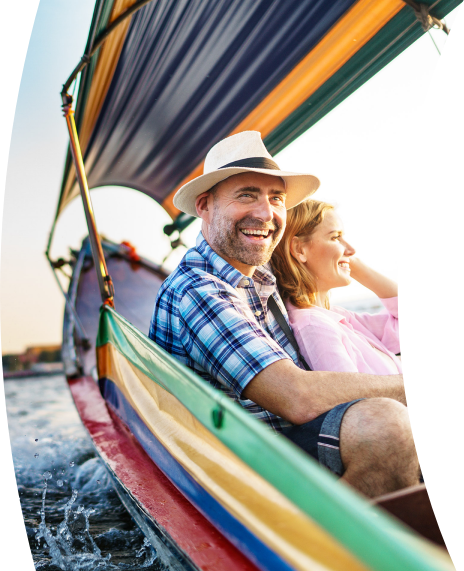
Work Together
Solutions for businesses of any size. Tools designed with your needs in mind. Our global network is full of opportunities to help your business grow.

Give Back Together
Turn your passion into action to support local causes with Diners Club Together for Change. From dining events to beach cleanups and more, we can make the biggest impact if we work together.
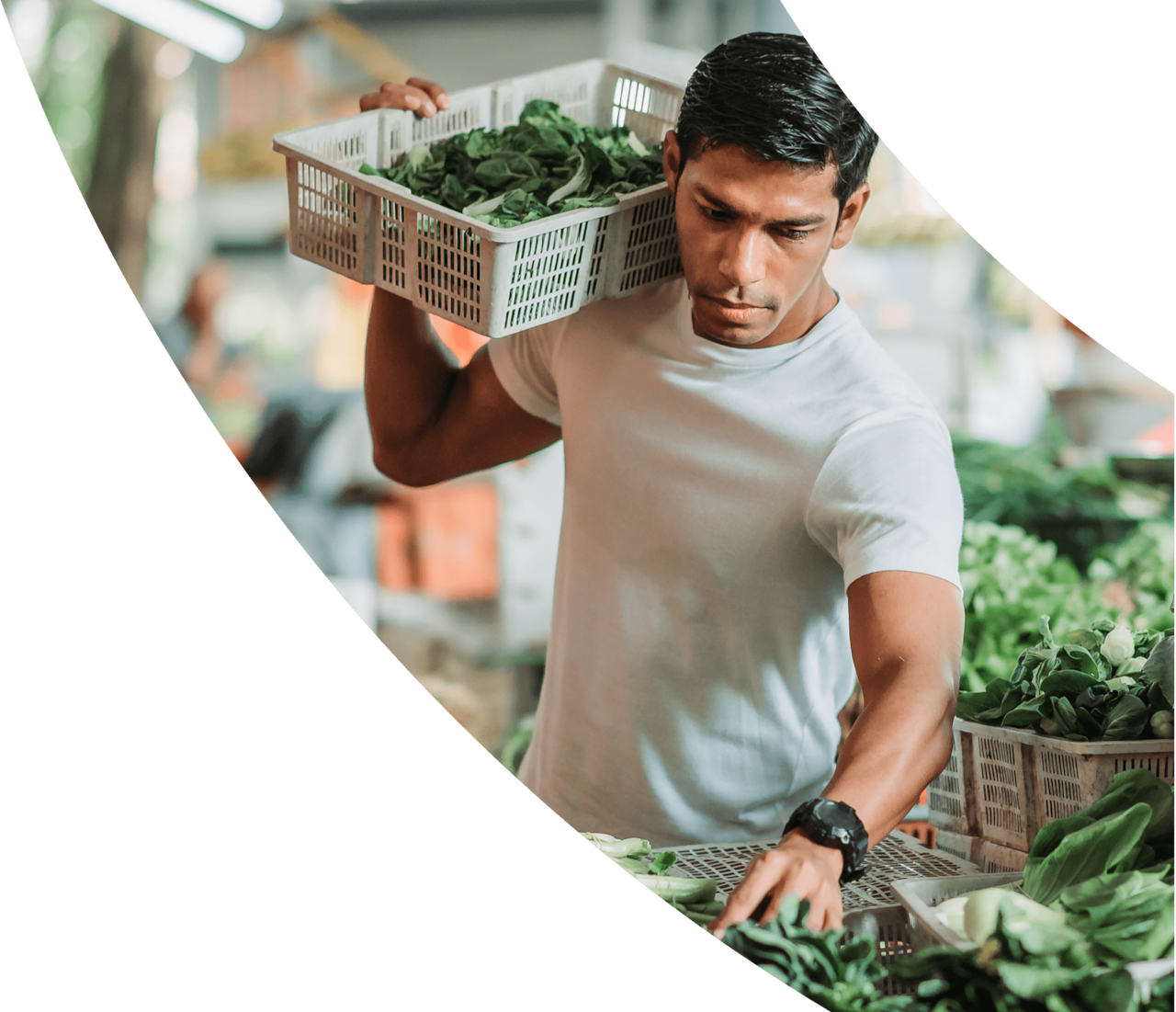
Together for Change
Learn more about how we – along with our issuers and Clubmembers – are giving back.

South Africa
Our Diners Club issuer is on a mission to empower young women to pursue careers in South Africa's well-established winemaking industry.

JOIN THE CLUB
Enjoy access to world-class experiences, benefits and services. Apply for a card on the website of the local Diners Club in your country.
You are leaving Dinersclub.com
You are leaving Dinersclub.com and entering a website operated by a third party. Diners Club does not provide the products and services on the website. Please review the applicable privacy and security policies and terms and conditions for the website you are visiting. Diners Club does not guarantee the accuracy of any tools that may be available on the website.
http://instagram.com,https://www.facebook.com,https://twitter.com,https://www.linkedin.com,https://www.youtube.com,https://privacyportal.onetrust.com,https://optout.aboutads.info


Three Mind-Blowing Colombia Itineraries For One & Two Weeks
By Author Tom Osborne
Posted on Last updated: 6th October 2023
Fancy heading to a country which has it all? Colombia is the place for you. Whether you love sitting on a beach and swimming in warm tranquil waters, climbing mountains, tasting delicious food, chocolate or coffee, exploring ancient ruins or trekking through jungles – Colombia has something for everyone.
Visiting Colombia is perfect for a vacation or make it a longer adventure backpacking through Colombia.
As a huge country, it does require you to move around if you want to appreciate all of its diversity and the following Colombia travel itineraries aim to help you do just that!
The routes below for traveling through Colombia help you to navigate all of the most fascinating places to see and things to do , with options for a week, ten-day or two-week stay.
All are aimed at being both accessible and helping you to minimize your travel time. To help you travel as sustainably and environmentally-friendly as possible, I’ve tried to keep flights far and few between.
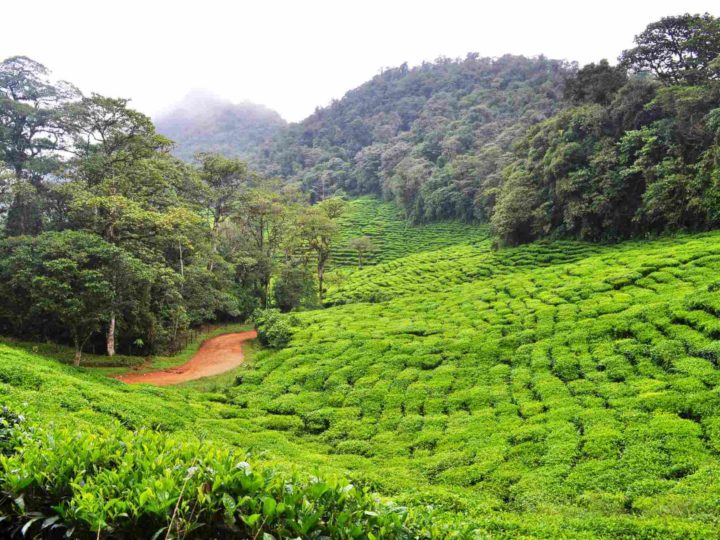
Click to navigate this article:
How to plan a trip to and travel around Colombia
- Colombia is a big place. Whenever travelling remember: less is more. Plan your Colombia itinerary to allow you to take your time and get to know the culture and the places you are visiting before jumping on a bus or plane to your next spot.
- Flying is a relatively affordable means for traveling through Colombia, particularly if you book in advance. It can save you a lot of time, too. There are a few different airlines and most routes are serviced by more than one. It is not uncommon to find a one-way flight between Santa Marta and Medellin for as little as $40-$60 USD, for example. Key airlines: Copa, Avianca, Satena and LATAM (Check for the best prices via Skyscanner.com ) Some will include baggage in their fare but others won’t. Be sure to check this before you book!
- Buses are also really reasonable in price per distance traveled. However, a lot of the routes are very long and some are notorious for pickpockets. I never had any problems but we did meet people who had had items stolen from their bag whilst they were sleeping on the route between Cali and the Ecuadorian border. To keep yourself and your items safe, carry a money belt (applicable for any travel in Colombia), and if you have to take a night bus, make sure your valuables are on your person at all times.
- Wherever you are coming from, you may well have to fly into Bogotá. Colombia has so many incredible places to see; sadly Bogotá is not one of them. If you can, try to begin your trip in Medellin, Cartagena or even Cali. If you are flying into Bogotá, you can easily take a connecting flight elsewhere.
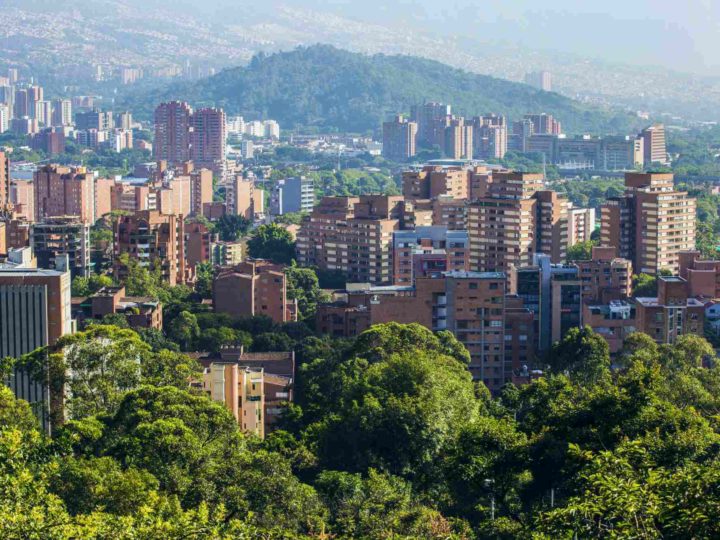
One week in Colombia itinerary
Medellin – guatape – jardin – salento .
There is so much to see and do in Colombia; however, for me, the area around Medellin is the absolute highlight.
This Colombia travel itinerary couples the country’s most interesting city with the coffee-growing mountains around Salento and Jardin .
If you are looking for a Colombia itinerary to help you explore this glorious country in one week, this is where to head.
Days One and Two: Medellin
Medellin is one of the most notorious cities on the planet and also one of my absolute favorites. It’s a vibrant, youthful city that is the capital of the Paisa region – whose people are known for their remarkable hospitality.
Book yourself in advance on the walking tour with Real City Tours for your first morning in Medellin. The tours start at 9.14am, 10.24am or in the afternoon at 2.19pm (yup, seriously) and are free but, like most others in cities across South America, run on tips – which you will definitely want to do.
The guides are engaging, personable and thorough in their explanations of the journey of Colombia for the past 100 years or so. They are frank and mainly from Medellin so they have first-hand stories of the tragedies that have taken place here.
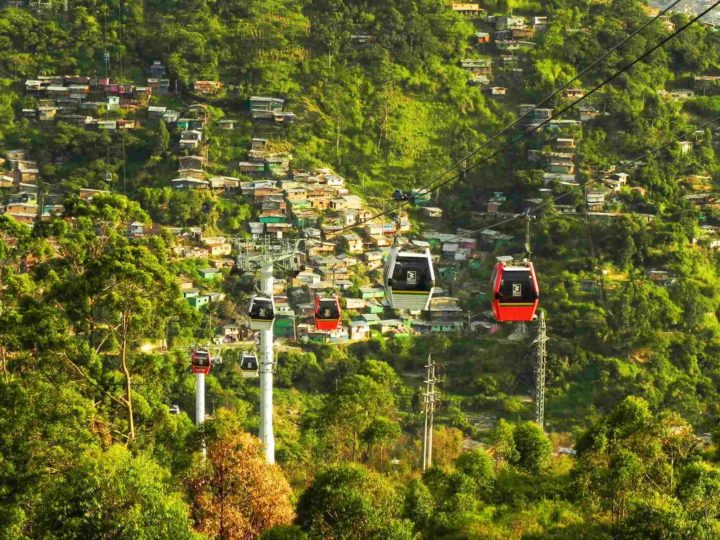
In the afternoon, head out to the gondola, which takes you up into Park Arvi for a spectacular view over the city. To get there, take Metro line A up to Acevedo before changing onto line K (the gondola). Once you get to the end of line K, you’ll transfer again onto line L. A ticket on this gondola is $6,000 COL ($1.80 USD) each way.
Top Tip: If you only want to ride up and straight back down again, you only need one ticket. If you get off the gondola and want to walk around the park, you’ll have to pay again.
Medellin is well known for its lively nightlife. If you’re staying in El Poblado , you’ll be right near the heart of the action. Check out three great bars: El Social (Carrera 35#8a-8) has a more local vibe, Mad Radio (Calle 8a # 33 – 40) has good and sometimes live music (it is a radio station too!) and great cocktails, and Panorama (Calle 8 # 34 – 33) also has great cocktails and a lovely view of the city.
For later on there are many clubs offering loads of different music styles. Try Calle 9+1 for everything from underground house to disco and techno.
On your second day in Medellin, head to Comuna 13 , which was the nucleus of the cocaine empire that once existed in this city until the early 90s.
It’s now perfectly safe and boasts a newly installed set of escalators, which takes you up the hillside and graffiti from some of the most talented street artists from Colombia and across the world.

There are plenty of free tour options. Or, if you’ve already been on the Real City walking tour, I’d recommend heading to Comuna 13 by yourself and exploring it on foot.
To get there, hop on the Metro to San Javier (orange line out of San Antonio) and then punch in “ Escalator Comuna 13 ” on Google Maps, or click here. It’s perfectly safe during the day to walk around (you’ll see plenty of other tourists) or you can hop in a local taxi or Uber.
Top Tip: as you head up the hill towards the start of the escalators along Carrera 109, make sure you stop off at the small empanada shack with a blue sign above it. The lady selling them is delightful and so are her empanadas !
In the afternoon head to the botanical gardens to see the nicest park in the city, full of beautiful flowers attracting plenty of birds. To get there, take the Metro to Universidad.
Feeling peckish? Check out the restaurant in the middle called IN SITU for good food in a sea of tranquillity – a great escape from the madness of the city.
Depending on when you are in Medellin, you may be able to catch an Atletico Nacional football match. The team aren’t amazing but the atmosphere is incredible. Tickets are super reasonable ranging from around $18,000 – $40,000 COP ($5-$12 USD). You can buy them at the stadium before the game.
Where to stay in Medellin: There are plenty of brilliant places to stay in Medellin ; we recommended the art-inspired 23 Hotel , with its spherical windows and mountain views from the bathroom!
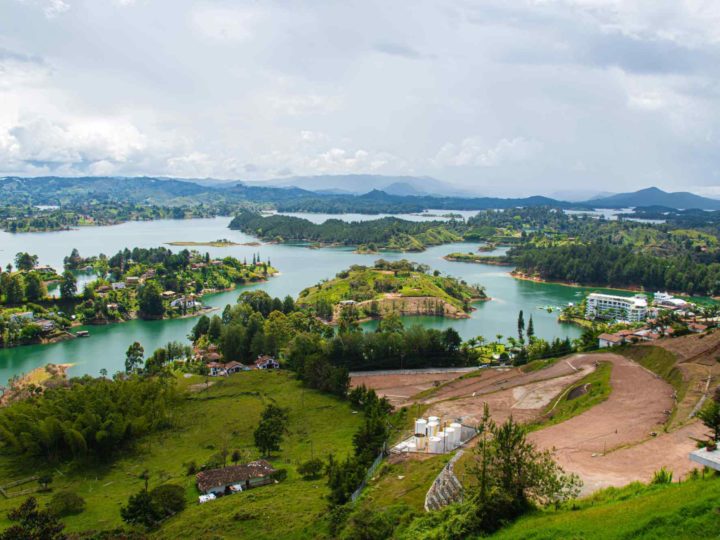
Day Three: Guatapé
On the third day of this Colombia travel itinerary, you’ll want to head out on a day trip to the beautiful town of Guatapé . Sitting on a lakeside, this quaint town is just two hours from Medellin and is perfect for a day trip.
The highlight here is a hike up to the top of El Peñol for spectacular views of the huge lake, considered one of the most picturesque in all of South America . It costs 18,000 COP ($5.30 USD) to hike El Peñol and you can buy drinks and snacks at the bottom or at the cafe at the top. Spend the rest of your day wandering the beautiful streets or grab a coffee and chill in one of the plazas.
To get to Guatapé take a bus from Terminal Norte , which is located next to the Caribe Metro Station on Line A. Tickets are sold at either booth #9 or #14 in the terminal and shouldn’t cost more than $15,000 COP ($4.50 USD). Once on the bus you can choose to be dropped in the town center or at El Peñol.
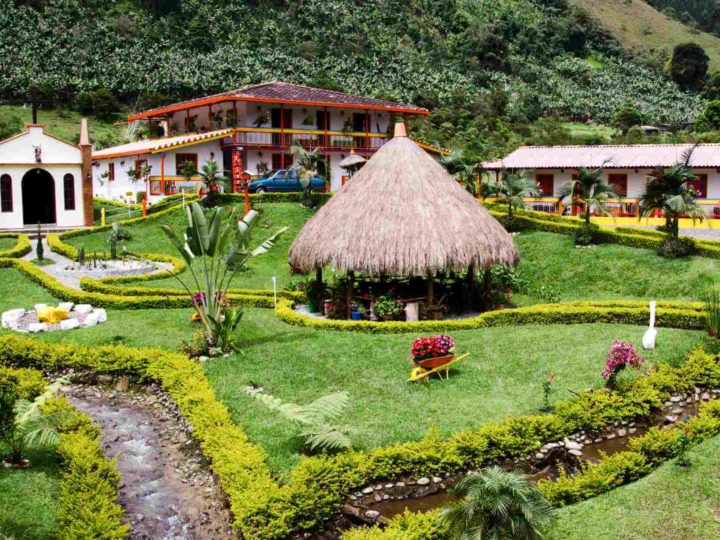
Days Four and Five: Jardín
From Medellin, hop on a bus to Jardín . Tickets should be $27,000 COP ($8 USD). It takes three hours or so and departs from Terminal Sur .
Jardín was one of my absolute favorite places in all of Colombia (read our complete guide to Jardín ). It is delightfully set in the mountains, surrounded by the greenery of the banana and coffee plantations. The town is quiet and rustic and the plaza in the middle is completely idyllic – perfect for grabbing a coffee or two and sitting for a few hours in the morning.
After some lunch head off on an easy stroll up through the banana and coffee plantations to the old yellow gondola, Garrucha . Here is a route map .
Chill out for a bit in the cafe at the top of the gondola, which boasts lovely views over the town and the surrounding mountains. Head back down in the gondola $7,500 COP ($2.30 USD) per person, as it rattles just over the top of a plantation. It’s quite an experience!
A great way to spend an hour or so wandering around and getting your twitching fix is in the Parque Nacional Jardin de Rocas. You can see the strange but beautiful (and wonderfully named!) Andean cock-of-the-rock, as well as hundreds of smaller and beautifully colored birds dancing around the flowers and fruit left out for them to eat.
Entrance is 10,000 COP ($3USD). The website claims you should contact them in advance to book a spot to visit, however, we just turned up rang the bell and the owner came out and greeted us with a warm smile.
If you fancy a sweet treat in the late afternoon, head to Dulces Del Jardin , a family-run dulceria which is famous for its arequipe , a sweet spread a lot like dulce de leche . They also do a cracking pana cota and arroz con leche (rice pudding).
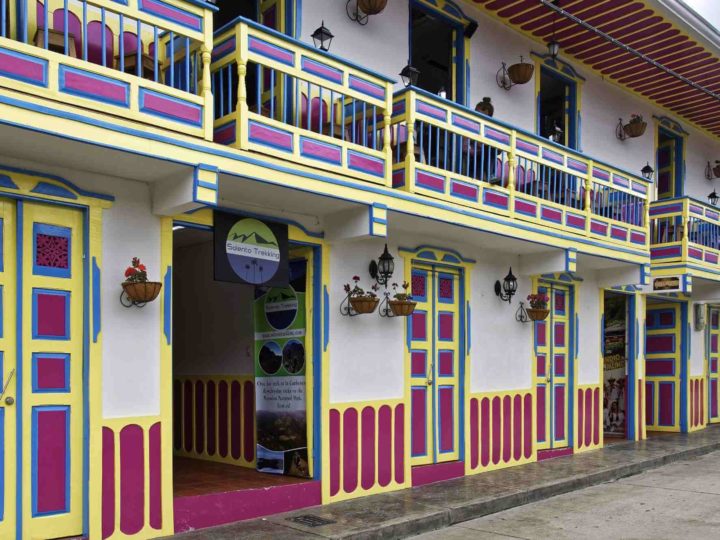
Days Six and Seven: Salento
Nestled in the Los Nevados mountains, the beautifully picturesque town of Salento is surrounded by lush green fields and plantations. This is the beating heart of Colombia’s coffee-growing region, where you can learn why this is one of the best places on earth for coffee beans.
Take a jeep from the plaza in the center of town and head out to one of the many fincas (coffee estates). Don Elias is a small, family-run finca, with a short but personal tour that leaves hourly. Finca El Ocaso is bigger, with a longer tour which goes into more detail about the coffee-making process, from berry to cup.
Both give you a good idea of how it all works. All the cafes around Salento will serve great coffee if you just want to drink as much as you can.
Another top thing to do in Colombia is play the national game, tejo . This game is essentially throwing rocks at gunpowder and Salento is supposedly where it comes from. Head to one of the two best spots: Bar Danubio (pool upstairs, tejo downstairs) or Los Amigos.
Don’t be afraid to get involved. The laws of the game are written in English and the people working there are super friendly and helpful. Most importantly, the beers are cheap and the rum measures are large! Plus, if you hit that gunpowder, it’s utterly exhilarating.
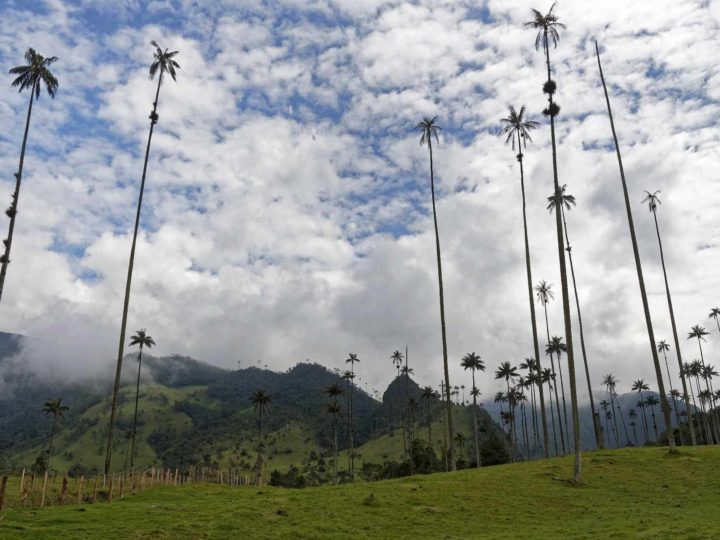
Finally, the Cocora Valley hike is one of the highlights in all of Colombia. Here you can walk amongst the tallest palm trees in the world. The trail is essentially a loop with a small detour halfway to a gorgeously situated finca that sells wonderful coffee and hot chocolate for you to sip on as you watch hummingbirds dancing around you.
Read our complete guide to Los Nevados National Park for more information.
To get here:
- Get an early jeep from Salento (they leave at half past the hour every hour from 6.30am from the main square and cost $3,600 COP ($1USD)); you will avoid the tours this way.
- Begin the loop by heading down the right side. The track up this side is narrow and a bit muddy and there is one point where you have to negotiate a steep hill. By starting on the right, you go up the narrow, occasionally muddy track instead of down – something you’ll likely find easier.
Top Tip: Get a jeep ride over to Filandia for an afternoon of people-watching and coffee-drinking in the quaint, beautiful plaza and get amazing views up the mirador tower just a short walk from the town.
From Salento you can either get a bus back to Bogotá or to Medellin. If heading to Bogotá, you’ll have to go back to Armenia and catch a connecting bus. You can also fly from Armenia to Bogotá, as there are three flights a day.
If heading to Medellin, there are a number of direct buses from the bus terminal in Salento. The timetable changes regularly so head to the terminal a day or so before you plan to leave to check the times and buy a ticket as the most popular buses can sell out.
10 Days in Colombia: Travelling through the south
Cali – popayan – san agustin – tatacoa desert – salento.
If you have 10 days in Colombia, start in Cali , heading south on a largely untrodden tourist path.
Here, you can discover the mysterious, ancient pre-Columbian civilizations, watch the sunset over the colonial city of Popayan , star gaze in the desert, and finish in the coffee plantations of Salento.
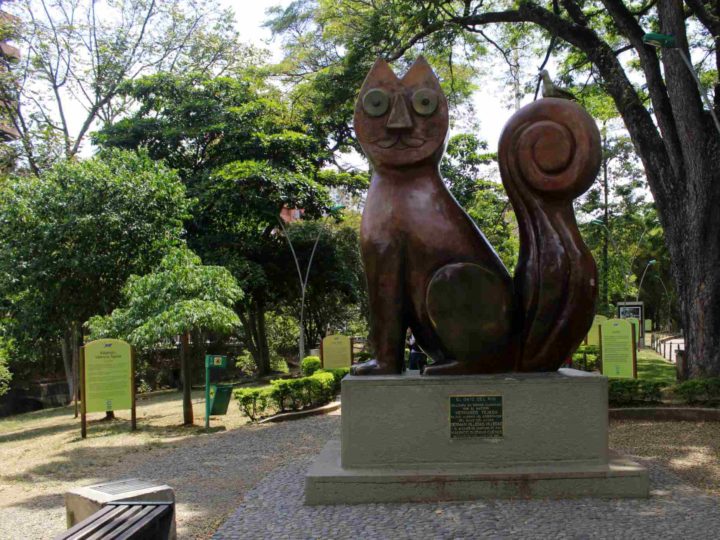
Days One and Two: Cali
Spend your first few days of this ten-day travel itinerary getting to grips with Colombia by learning how to salsa like the best of them in Cali.
By day, wander the streets of Barrio San Antonio (the bohemian district in Cali) dotted with cafes and bars and explore the nearby Iglesia de San Antonio (Carrera 10). In the evenings, dance the nights away in the party capital of Colombia.
For the best music, make sure you check out: Zaperoco Salsa Bar ( Ave. 5 Norte #16 ), one of the oldest institutions with great music, so either sit back and listen or get on the floor and dance! La Topa Tolondra ( Calle 5 #13-7 ), is another bustling bar with live music.
Cali isn’t safe to walk around at night, so always take a taxi – Uber works here.
Days Three and Four: Popayan
Heading south, catch a bus from Cali to Popayan (2.5-4 hours). It follows the Panamerican Highway so the journey is smooth and easy. Multiple services run each day from the bus terminal in Cali.
Spend a day wandering Popayan and exploring its cobbled streets, delightful churches and a picturesque plaza, Caldas Park . The food here is really good too, as it’s home to the particularly moreish empanadas de Pipian , which are filled with potato and served with a delightful peanut and chilli dip. The best place to try them is La Fresa (corner of Calle 5 and Carrera 9).
For sunset, grab a few beers and head up Cerro El Morro for a spectacular view over the city. The climb up the grass bank is pretty steep if you head up from the main street so bring appropriate footwear! Otherwise, you can take the gentler path via Calle 1BN.
For your second day, you have two options:
Visit the famous market in Silvia
Head to the market in Silvia where people from villages in the surrounding mountains congregate every Tuesday. This is more of a food market so you’ll be able to try some local delicacies and empanadas, but the best part is just wandering around, talking to the locals and generally soaking up the atmosphere.
Most hostels and hotels advertise tours for Silvia, however, the cheapest and best option is to hop on a bus from the Popayan bus terminal. Look for the bus company Coomotoristas.
Buses are frequent throughout the day but it will take over an hour to get to Silvia so head off early to catch the best of the market in the morning.

Purace National Park
Want to see a condor up close? The Purace National Park is home to three condors as well as a really interesting variety of wildlife. The park ranger will put out some meat on a rock, which juts out from the edge of a cliff to bring the condors closer.
Unfortunately, bus timetables make this trip impossible to do on your own if you want to really enjoy the park. Therefore, the best option is to take a tour. There are a number of tour operators running these but they appear to change quite often.
We went into the tourist office just off the main plaza in Popoyan and got all the information we needed from there (FYI the tourist office on Google maps is incorrect. You’ll find it on the west side of the plaza ). If you want to book in advance, Popayan Tours run day trips.
Days Five to Seven: San Agustin
San Agustin is the best spot in all of Colombia for archaeology. Here, a civilization that we unfortunately know little about existed for some 1,000 years from around 1 AD has left us with hundreds of beautifully carved and well-preserved statues, which are well worth the arduous journey to reach.
To get to San Agustin from Popayan on what is a slow but scenic drive (roughly four hours), there are a number of departures from the bus terminal in Popayan. The times are subject to change so head to the bus terminal the day before and purchase a ticket.
Note that, while you have a ticket to get you to San Agustin, the bus will not take you all the way there because it will most likely carry on to Pitalito. Don’t panic, the driver will get out and flag down one of the regularly passing collectivos for you, which will take you the rest of the way, for no extra cost.
The following day, head out to the Archaeological Park . It’s located around five kilometers from town so it is perfectly possible to walk.
Otherwise, it is relatively inexpensive to take a bus or taxi from town. The park is split over a number of different sites and has a brilliant museum, which is a great starting point for any visit.
A walk up to Chaquira for a bit more archaeology and some great views is highly recommended.
For your second day in this beautiful town, take advantage of a horseback or jeep tour of the other sites around the town. Both take you out into the beautiful countryside and could include: visiting the highest waterfall in Colombia – ‘ Salto de Bordones ‘ – or some of the other amazing archaeological sites in the area, such as Alto de los Ídolos and Alto de Las Piedras .
Most hostels or hotels will be able to set this up for you so ask at reception. If they don’t, there are tour agencies just off the plaza in town.
Horseback tours should cost between $50,000 COP-$70,000 COP ($15-$20 USD) per person depending on whether you have a private or group tour. For a jeep tour, it will cost between $40,000 COP-$50,000 COP ($12-$15 USD) per person.

Day Eight: Tatacoa Desert
From San Agustin, head north to visit the sparse desert-like landscape near Neiva , the Tatacoa Desert . Here, you can cycle through the barren lands in the day, swim in a pool in the middle of the desert and star gaze from an observatory at night.
The Tatacoa Desert is split into two parts: the red and grey. In the morning, cycle out into the grey desert. Aim for the Los Hoyos , which is where the swimming pool is. Next to the pool is a 30-minute walking loop you can do out into the desert to get close to eccentric-shaped sand banks.
Most hotels and hotels rent bikes for around $4,000 COP ($1.30 USD) per hour. Another option is to hire a tuk-tuk, which will cost around $60,000 COP ($18 USD) for a round trip.
After 4pm the sun will have calmed down a bit so head out into the red desert. Take the trail from the back of La Guaca hostel. There is a map and it is well-signposted along the way.
Later that day, book yourself onto an evening tour of the Astronomical Observatory Tatacoa for a bit of stargazing.
To get to the Tatacoa Desert from San Agustin, it’s a bit of an adventure, but completely worth it!
First take a jeep as early as you can from San Agustin to Pitalito, they depart from the corner of Calle 3 and Carrera 11 and cost between $5,000 COP ($1.50 USD) and $7,000 COP ($2 USD) per person.
Upon arrival at the Pitalito bus station, take a bus north towards Neiva (four and five hours, $25,000 COP-$38,000 COP ($6-$11 USD)).
From Neiva, take a jeep to Villavieja with the bus company Coomotors. Jeeps leave hourly until around 6pm and cost $8,000 COP ($2.50 USD) per person and take two hours. Once you have made it to Villavieja, jump in a tuk-tuk and head into the desert to your accommodation.
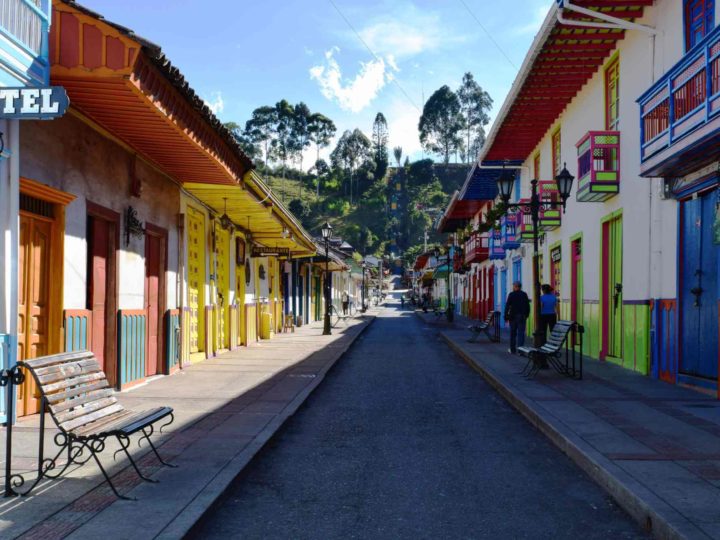
Days Nine and Ten: Neiva to Salento
From the desert, head back to Villavieja and onto Neiva. The jeeps depart from the square in the middle of Villavieja where you were dropped on the way here. There is a Coomotors bus from Neiva to Armenia which departs at 12.30pm and $60,000 COP ($18 USD) per person. The bus takes six-seven hours.
Once you make it to Armenia, there are buses, which run to Salento or Filandia and go regularly between 5.30AM and 8PM. You don’t need to buy a ticket from inside the terminal for this bus as it is considered a local service.
Follow the signs for the local buses and once outside keep walking around to the right and you’ll find a bus with ‘Salento’ on the front. It costs $4,000 COP ($1.20 USD). If you arrive late or don’t fancy the bus, taxis are readily available from the terminal and should cost around $20,000 COP ($6 USD) to Salento.
Spend your final day in Salento as per the itinerary above.
Two Weeks in northern Colombia
Cartagena – rincon – caribbean islands – minca – tayrona national park – palomino.
Colombia’s northern coast is home to one of the most beautiful and romantic cities in the world, with crystal blue waters, white sandy beaches, and deserted islands.
On this Colombia vacation itinerary, spend two weeks beach-hopping, exploring Cartagena and the beautiful Tayrona National Park .
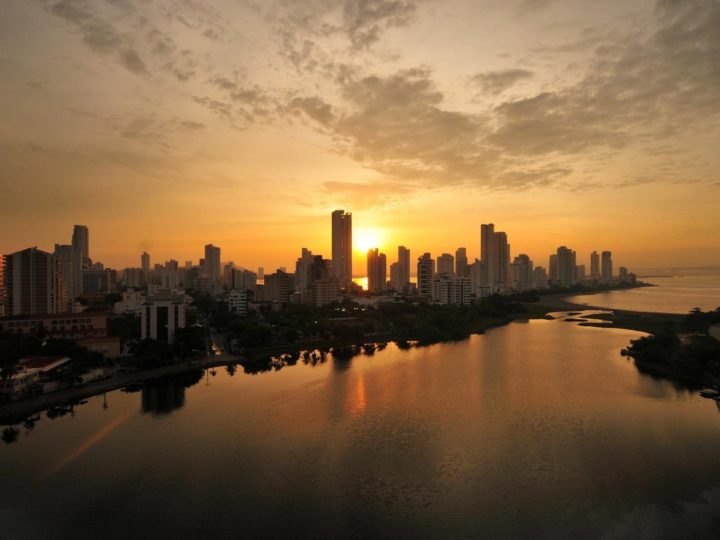
Days One and Two: Cartagena
The beautiful, walled city of Cartagena was made for a few days of wandering its streets – although given the heat, which is unbearable by midday, you’ll want to get out early and enjoy a mid-afternoon siesta. We’ve got a full guide to Cartagena on the site, but you can also keep reading below for some further great suggestions.
Start by heading to the castle to learn about the conflict between the Spanish and English (and pick up an audio guide, which is both hilarious and informative).
After that, head back across the river and into the streets of the beautiful neighborhood Getsemani. Stroll around streets packed with colorful buildings and look out for street art.
For lunch, grab an arepa on the go, from Colombitalia Arepas . Arepas are a corn tortilla and are everywhere in Colombia. Served with breakfast, lunch and dinner. Here you can get one with pizza toppings on – delicious!
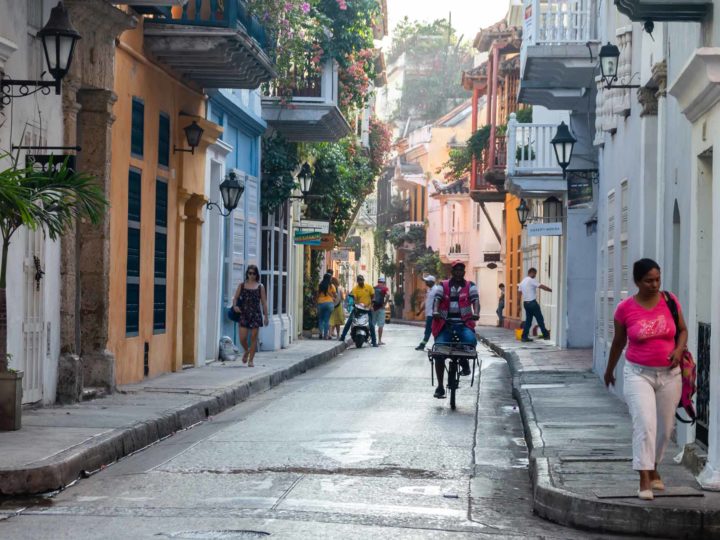
In the evening head into the old town for a stroll around the cobbled streets. High-end shops and fantastic ice cream sellers (check out Gelateria Tramonti ) are the main attraction here.
For sunset, get to the famous Cafe del Mar on the city walls early to grab a table. Otherwise, just hang out anywhere along the wall and people will come around and offer you a beer if you fancy.
For dinner, swanky restaurants abound but for something really special, check out Interno , the first restaurant in the world to be run from inside a women’s prison, where practically all staff are prisoners.
The food is excellent – you’ll pay $90,000 COP ($26 USD) for a set menu. For fantastic steak, check out Quebracho .
Stay overnight in one of our favorite hotels and guesthouses in Cartagena , whatever your budget.
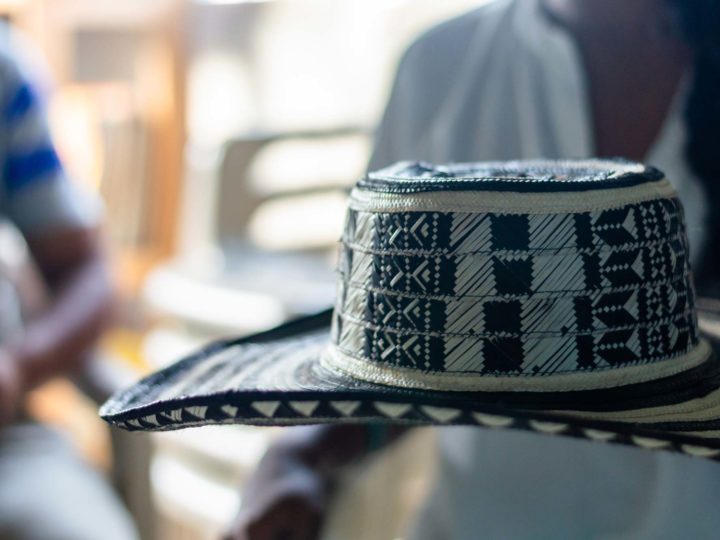
The next day, gain a unique perspective of Cartagena and Colombia with a tour led by the Zenú , an indigenous people who have been forced out of their homes through the centuries and now survive selling coffee on the streets of Cartagena (read all about founder Steph’s experience of this sustainable Cartagena tour and book here ).
Few tourists ever even hear about the Zenú. Not only will you see the city in a different light as your guide narrates the story of Cartagena from an indigenous perspective, but you’ll learn about their struggles for justice and exceptional prowess when it comes to craftsmanship, as you visit their workshop to see how caña flecha is woven into the famous Colombian hat, the sombrero vueltiao .
Help support sustainable, responsible tourism in Cartagena by booking this Zenú Indigenous Heritage Tour with IMPULSE Travel Colombia and get a 5% discount by using the code WORLDLY5 at checkout.
Alternatively, head outside the city; our guide to the best trips to take from Cartagena can get you started.
Days Three and Four: Rincon
Just a few hours away from Cartagena, is the quaint fishing town of Rincon del Mar . Here you can fall out of your accommodation onto the beach and spend the day lazing in a hammock and swimming in the tranquil, warm waters of the Caribbean Sea .
Get a room at Dos Aguas Lodge , by far the best spot in Rincon with a beautiful quiet beach right outside your door.
Rincon is also a fantastic spot to launch yourself into the San Bernardo Islands (you can see them from the shore!). If you don’t have much time, take a day trip out to the islands leaving at around 8AM and returning at 2PM (Colombian time of course…things are very relaxed here and don’t always run on time).
Tours cost $60,000 COP ($18 USD) per person and can be booked from any of the families living along the beachfront.
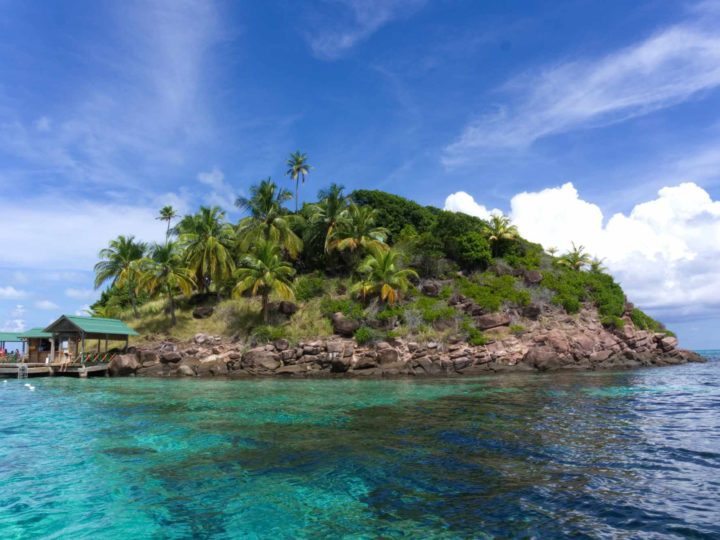
To get to Rincon, take a 25-minute taxi journey to the bus terminal outside Cartagena. Hop on a bus to San Onofre (2-3 hours, $20,000 COP-$30,000 COP ($6-$8 USD)) and let the bus driver know you want to get off in San Onofre (it continues further).
When you arrive, take a moto for $10,000 COP ($2.5 USD) or a taxi for $20,000 COP ($6 USD) to get you to Rincon – there is no bus for this route. If it’s night, a taxi is safer.
Days Five and Six: Find your paradise and stay a night or two on a deserted island
From either Cartegena or Rincon, you can sail out to paradise and live on a private island. Head to Isla Baru or Playa Blanca for white sandy beaches, palm trees, crystal clear waters, go snorkeling or just sunbathe in this heavenly escape.
Isla Grande : Pick up a local guide to explore secluded beaches, chill on the beach and relax by a bonfire as the sun sets.
Days Seven to Nine: Minca
Minca has become a must-visit for anyone taking a trip along Colombia’s north coast. An inland town surrounded by forest, it makes a strong contrast to the seaside stops along this route.
While in Minca, you can go bird watching with Jungle Joe, head up to the beautiful waterfalls at Pozo Azul (walk up the track on the left of the first pool for a quieter spot and some rock jumping!), have lunch on the deck of the Lazy Cat restaurant and look out for the iguanas in the trees.
Finally, if you aren’t staying there already, head up to Casa Loma hostel for sunset. They have a beautiful deck and bar set up for watching the sun go down. Minca is known for its dramatic and colorful sunsets.

To get to Minca, you need to travel through Santa Marta . You may decide to stop in Santa Marta to break up the journey.
Buses run to Santa Marta from Cartagena bus terminal and it will take between five and seven hours (it took us six and a half). They depart regularly throughout the day so you’ll be able to turn up and buy a ticket when you are ready to go.
From Santa Marta you can take a collectivo jeep from the town at the corner of Calle 12 and Carrera 9 and will cost between $7,000 COP-$8,000 COP ($1-2 USD). You can also take a taxi for $40,000 COP-$50,000 COP ($12-15 USD). The journey will take between 45 minutes to an hour.
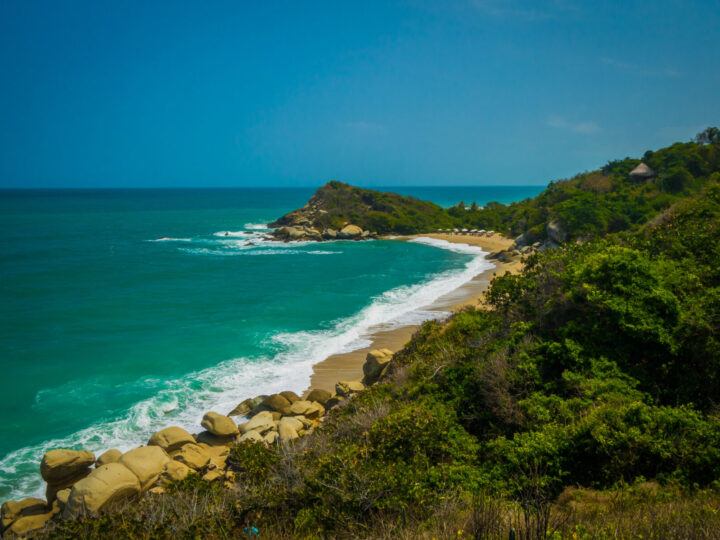
Days Ten and Eleven: Tayrona Park
The Tayrona National Park is one of the most famous spots in all of Colombia. It hugs the Caribbean coast of Colombia and is home to some of the most beautiful beaches in the world. Think white sand, crystal clear waters, and beautiful palm trees. The best bit is that roads only get you so far which means much of the park remains an untouched wilderness for you to explore.
Because of the inaccessibility of the park, and the fact it is basically rainforest, it is very hot and very humid and the accommodation is very basic. Because of this, it’s recommended to only do either a day trip or stay just one night in the park.
For a day trip, the best option is to stay the night in one of the many accommodations lining the road near the main entrance and then head into the national park the following morning.
Either Eco Hostel Yuluka (they have a swimming pool with a slide!) or Villa Del Rio (the father of the guy who runs it will give you a lift to the park entrance in the morning for free!) are great choices.
For an overnight stay in the park, book a cabin at Playa Brava – a white sandy beach where a family run a small hotel with cabins.
All the other options in the park are either sleeping in hammocks (pretty close together) or tents (these get incredibly hot!).
You can also stay at Cabo San Juan , which has a few camp spots, hammocks, and cabins. For both sets of accommodation, it is incredibly important to book in advance.
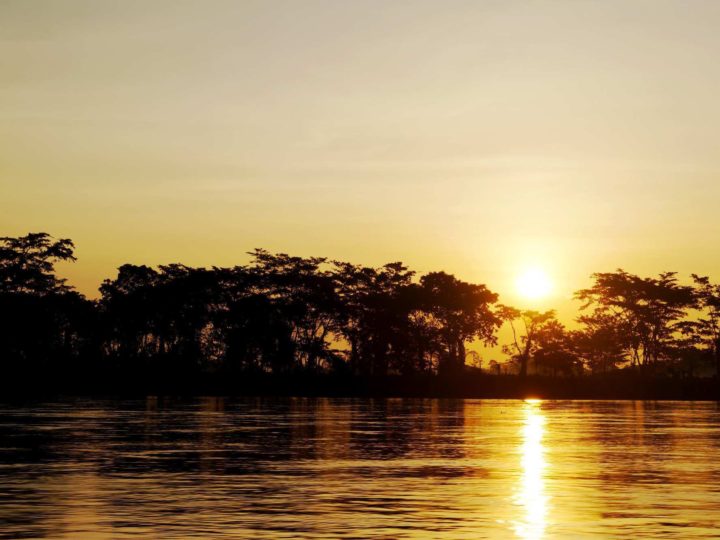
Days Twelve to Fourteen: Palomino
Palomino is a delightful sleepy beach town, perfect for taking some time to chill out, do a bit of tubing in the river, and generally relax by the sea. There is one main street, which runs all the way from the main highway down to the beach.
Most of the places to stay and eat line this one street and it takes around 10 minutes to walk. As you stroll down to the beach, you’ll find people selling the tubing experience if you are interested.
The town is known for its excellent fish: eat at 7 Mares (reserve a table and get a free dip selection on arrival!), Bitacora and La Frontera Pizzeria .
Casa Colibri is a great place to stay; the rooms are excellent, large, light and comfortable, some of which have air conditioning, the breakfast is amazing, a medley of breakfast dishes, pancakes, eggs, yogurt, granola, and Joe, the owner, is informative and lovely.
To get to Palomino, take a taxi from the exit of the Tayrona National Park, or flag down one of the buses that pass every 30 minutes or so along the road. You’ll be picking them up as they run from Santa Marta to Riohacha.
To return to Bogotá or Medellin for your flight home, return to Santa Marta by taxi or bus.
Optional Extras for any Colombia travel itinerary
Bahia solano – six days.
My favorite place – and a truly unmissable place to see in Colombia – is Bahia Solano , an under-visited and largely untouched paradise on the Pacific coast of Colombia. Here you can meet humpback whales, see dolphins from the shore, trek into the jungle, swim with bioluminescent plankton, and relax on your own private beach.
There are a lot of options for places to stay in the Bahia Solano area and in El Valle (a town 30 minutes south of Bahia Solano) but without a doubt the best possible place to stay is at Mecana Beach Eco Hotel .
From its location on Mecana Beach , you can hike into an area of jungle that is protected by the hotel and is packed with interesting wildlife or visit a local indigenous community.
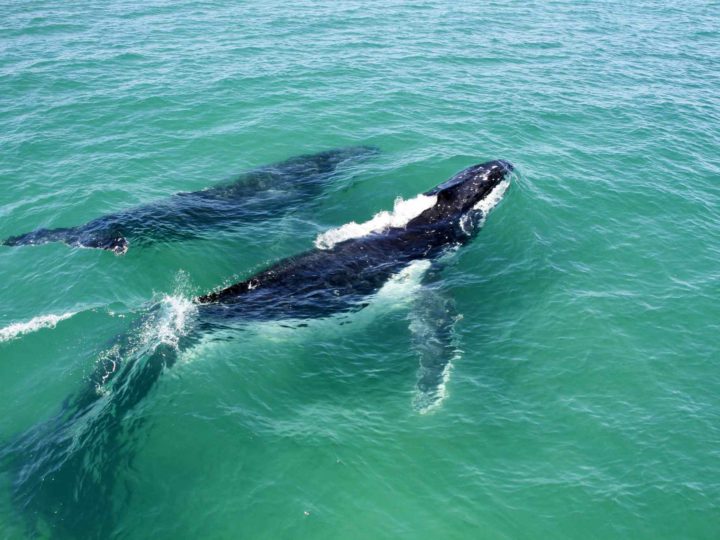
What’s more, between June-October every year, up to 14,000 humpback whales migrate to the area to mate, reproduce or nurture young calves.
For the best chance to spot them, take a tour with the lovely people at Mecana Eco Hotel ($350,000 COP ($105 USD) for two people, less if in a group), the biologists and Madre Agua ($150,000 COP ($45 USD) per person), or with a local captain (this is the cheapest way – although prices vary).
Normally, I always want to support the local economy wherever possible but I have to recommend that you go with either Madre Agua or Mecana Eco Hotel .
The reason being you go out with people who study whales and love the whales. You get more scientific information about their behaviors and the Madre Agua crew even have a microphone they can put in the water so you can hear the whales.
But most importantly, by going with either of these two, you will ensure that your visit does not interrupt the natural habits of the whales. As both have biologists in the team, they know where a boat should be and how far away it should be to ensure this.
To get here you have two options:
- Take a boat from Buenaventura ; this takes nine hours and is the cheapest option. However, Buenaventura is the main export port for the cocaine trade in Colombia. We met many people who traveled through here. However, it is still one of the more dangerous cities in Colombia.
- Take a flight from Medellin. This is the best option and the most enjoyable. You can either fly with Satena (one or two flights per week) or with San German . Crucially, San German is only available to buy direct from them, they will not pop up on Skyscanner . The flight takes around one hour and is normally in a very small 12-seater plane!
Top Tip : the San German flights go from the smaller city center airport in Medellin, called Olaya Herrera.
La Guajira – Four Days
At the very northern tip of South America lies La Guajira, an arid peninsula that feels a world away from the lush, water-rich landscapes of the rest of Colombia. Its indigenous people, the wayuu , were never conquered by the Spanish, and they retain a clear identity of their own, while their land is one of stunning contrast, framing untamed sand dunes against the deep blue Caribbean ocean.
Tourism is increasing here, slowly, and most come for the golden, powdery sand beaches along the very northern coast (Playa Taroa is perhaps the most beautiful) and the world-class windsurfing available at Cabo de Vela.
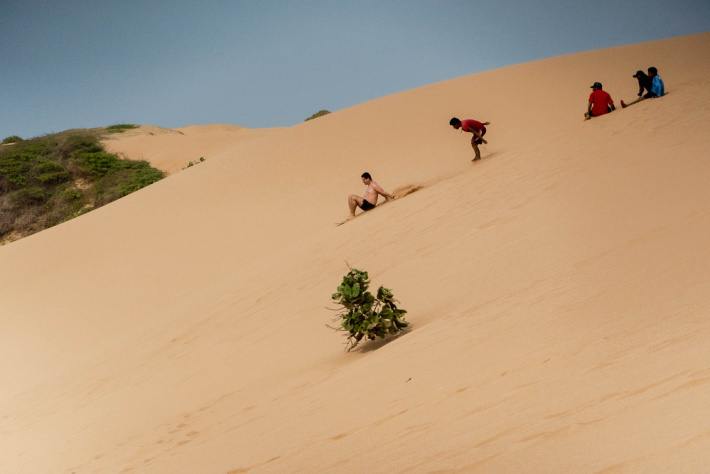
Tours leave from Riohacha, a full day’s drive south of the northernmost tip of the peninsula and are the best ways of exploring the region – particularly as public transport is practically non-existent. One of the poorest parts of Colombia – indeed, three-quarters of La Guajira families face food insecurity – jobs are scarce here, which is why it’s so important to visit using a reputable local operator.
You can do this by taking a four-day tour with Macuira Tours ($290 USD pp). Indigenous-owned, their guides really know the region and will give you a fascinating insight into the daily life of those who live in one of the most extreme environments in Colombia.
Friday 28th of July 2023
Love your itinerary but the price-points on your recommended lodgings are not feasible at all for backpackers or people traveling long-term on a budget, with many over $100/night.
Steph Dyson
Wednesday 20th of September 2023
Hi Amir, a lot of my readers aren't backpackers. Steph
Latitude Adjustment
Monday 29th of August 2022
Hello, Nice article and site you have. Not sure the timeframe when this was reported but a few points: Viva Air is a great airline to use and goes to most cities in Colombia and is more affordable than Avianca Guatape is overrun with tourists on the weekends. Folks should visit during the week Comuna 13 also is too crowded on the weekends. It is better to go with a tour guide so you get the history and a much better experience. Never go at night! Palamino is rustic and more geared toward backpackers. The beach is overrated. Go to Tayrona. Renting a car is a much better option as you see a lot more of the countryside and it is not that expensive and the roads are great, for the most part, but do not drive at night.
We are Expats living in El Retiro, Antioquia, Colombia for over 4 years now and travel extensively around Colombia.
There are many beautiful places to see in eastern Colombia as well.
Cheers, John and Susan Latitude Adjustment
Tuesday 19th of September 2023
@Latitude Adjustment, Any reason as to why we shouldn't go out at night? Just curious, thanks!
Thursday 19th of January 2023
Thanks for these helpful comments! Steph

Immerse Yourself in Colombia: An Authentic Travel Guide

Leaving from...
Going to...
Discover Destinations When to Travel How to get around Visa Food Other Tips
Discover Colombia
If you asked someone 30-odd years ago what they knew about Colombia, you’d probably get responses relating to drug cartels, danger and of course Pablo Escobar.
Since then Colombia has moved on dramatically. Just take the constant 10% increase in tourists year on year as an example of how this country has changed for the better.
We’ve created this ultimate guide to Colombia to share with you everything that this diverse country has to offer. Decided that Colombia is somewhere you HAVE to visit?
Check out our twelve in-depth guides to learn about the best things to do and see in Colombia.
Is Colombia worth visiting?

Colombia is one of the world’s most diverse countrie s, boasting two oceans, the Andes mountain range, cultural and thriving cities, flourishing jungles and with that native wildlife.
Housed across Colombia’s 59 national parks , you’ll find over 10% of the world’s animal species, making it a great country to explore if you love wildlife.
If exploring the wilderness is not what you are after, there’s no need to worry. Colombia has a number of energetic metropolitan cities that offer a great food scene, a number of historical sites and innovation spurred by the entrepreneurship that’s flourishing within the cities.
Destinations like Cartagena boast stunning colonial architecture that tells a story of years ago, transporting you back in time as you wander through its streets.
Throughout Colombia, you’ll come across a number of once-in-a-lifetime opportunities . Whether it be whitewater rafting, hiking, kitesurfing, horse riding, or diving…the list literally goes on and on!
Keep reading: Looking for inspiration on where to stay? Check out our list of 43 best places to stay In Colombia to discover the most unique and best-value accommodations out there.
Is Colombia safe?
Despite Colombia’s huge steps towards change, people are still asking the same question – ‘Is Colombia safe?’
In short, it’s safe to travel to Colombia , but you need to be aware of which places are better to avoid. We’ve put together a devoted blog that delves into travelling safely in Colombia . You can use this resource to help you decide whether Colombia is safe enough for you.
Best destinations in Colombia

Top 3 places to visit in Colombia
Colombia is a diverse country offering lots of different opportunities and adventures depending on where you go.
As hard as it is to pick, here are our top three places to visit in Colombia:
Medellin — an incredible and innovative city

Once home to the famous drug lord, Pablo Escobar, Medellin used to be considered one of the most dangerous cities in the world. Fast forward to now and Medellin has completely transformed itself into a thriving and innovative cosmopolitan city.
The city is considerably safer with a top-notch transport system via its metro system and cable cars, numerous stunning parks and delicious restaurants.
Another great thing about Medellin, due to its location, temperatures remain warm and pleasant , meaning you can visit all year round. If you are in Medellin, we also recommend taking the 2-hour bus journey from Medellin to Guatape as a day trip.
Cartagena — where the Caribbean and Colombia collide

Situated on Colombia’s Caribbean coast, Cartagena boasts some of the best-preserved colonial architecture in all of the Americas.
Once a crown jewel of the Spanish empire, you’ll clearly understand why it’s been made a UNESCO World Heritage Site after a few hours of strolling around Cartagena. The 13 km of ancient walls seemed to have preserved the city, giving you the feeling of going back in time.
Being on the coast, Cartagena isn’t too far from some amazing beaches including Playa Blanca. Inevitably though, this kind of beauty has attracted tourists from all over the world, meaning some of the popular sites and beaches can get very busy! It’s only a 1 to 1.5-hour flight from Bogota to Cartagena .
Tayrona National Park — some of Colombia’s best nature

Tayrona National Park sits in northern Colombia at the foothills of the Sierra Nevada de Santa Marta where they meet the Caribbean coast.
The national park is a large protected area perfect for travellers looking to explore some of the best beaches in Colombia or adventure through lagoons to picturesque cloud forests. The beaches offer great places to snorkel, whilst the jungles provide opportunities to hike amongst wildlife such as birds, lizards and monkeys.
It takes around 5 hours from Cartagena to Tayrona National Park , while it’s only 3 hours from Barranquilla and less than an hour from Santa Marta .
When is the best time to visit Colombia?
Due to Colombia’s proximity to the equator, temperatures remain stable throughout most of the year. Temperatures do vary depending on altitude, though. The higher you go, the colder it tends to be.
Here’s a rough guide of the average temperatures depending on altitude:
- < 1000 m – More than 24°C (Cartagena, Santa Marta, Cali)
- 1000 – 2000 m – ~ 20°C (Medellín, Manizales)
- 2000 – 3000 m – ~ 14°C – (Bogota, Pasto)
Colombia has two seasons, a wet and a dry one. The dry season is between December and March , considered one of the best times to visit Colombia, and the wet season runs from April to June and October to November . July to September can also be a good time to visit because it’s mainly dry, plus it’s whale season!
December to February is the busiest time
However, you won’t be the only person wanting to travel at the best time, so if you chose to visit Colombia between December and February, expect a lot of tourists. With more tourists come higher prices as businesses have the leverage to increase prices.
Travelling outside of these months can save you some money and also provide the opportunity to explore tourist sites without thousands of other tourists.
How to get around in Colombia
Colombia is a huge country with plenty of amazing destinations to explore. Around a third of the country is taken up by the Amazon Jungle where moving around is extremely difficult, but luckily the rest of the country isn’t quite as tricky to navigate.
Here’s a short overview of the main transport options:

When travelling around Colombia, one of your main forms of transport will be its extensive bus network. Long-distance buses tend to be relatively comfortable with reclining seats, air conditioning and toilets.
You’ll be looking for comfort as journeys between the big cities are pretty long . For example, Medellin to Cartagena is 14 hours, and Bogota to Cali is 10 hours.
The main bus companies in Colombia are Expreso Palmira, Bolivariano and Trejos , which also provide good service and easy-to-use websites.
A big tip when travelling by bus in Colombia is to wear warm clothes. We all love a bit of air conditioning, but those buses get seriously cold. Ten hours in arctic temperatures isn’t exactly going to be enjoyable!

Flying in Colombia is a popular option, especially for those short on time or who have a larger budget to play around with.
There are a number of domestic airline providers including the two biggest Avianca and Copa. VivaColombia is also a big player in the airline space and tends to offer the cheapest flights, but watch out for the luggage restrictions.
The majority of the time flights are more expensive than the bus, but it’s worth checking just in case, because the cost-time ratio may be worth it. Do keep in mind that taking a short-haul flight can be up to ten times more polluting than taking a more environmentally-friendly option like the bus.
By colectivo
Colectivos are small minivans or truck-style vehicles that are mainly used for short journeys within a city or between two that are nearby. This form of transportation is predominantly used by locals, meaning they’re usually cheap.
Make sure to agree on the price to your destination before getting in, though. They’re definitely not as comfortable as the bus and don’t have much space for your luggage. Because they don’t have set pick-ups and drop-offs, they can get you closer to where you want to be than the bus.
A big downside though is that they don’t leave until they’re full , so you could be waiting around for a while!
Although renting a car in Colombia isn’t a very popular choice amongst travellers, it doesn’t mean it’s not an option. You’ll need a passport, credit card and international driver’s license in order to rent a car with prices starting from around $17.
Sure, having your own car gives you the freedom to explore at your own leisure, but do consider that the road quality between some cities isn’t great and Colombians aren’t known to be the most careful drivers. Bus travel is also very convenient, so we would recommend using the available transport.
Colombia doesn’t have a train network , so unfortunately this isn’t an option!
Entry requirements and visa for Colombia
We all love to hear it, travelling to Colombia is relatively stress-free when it comes to immigration and Visas. A large number of countries are able to enter Colombia visa-free for a period of up to 90 days.
This includes countries such as the United Kingdom, United States, Australia, New Zealand and those within the European Union, amongst others. These countries are all included in the list of countries that don’t require a Visa .
In addition, all visitors are required to have a passport that is valid for at least 6 months after the date of entry, so make sure to renew your passport if it’s going to run out soon.
Proof of exit
Sometimes Colombian border force will ask you for proof of exit from the country in the form of a plane, bus or boat ticket. Other times they won’t. If you don’t want to take your chances but don’t know when you want to leave Colombia, there’s a way around it.
‘Rent’ a plane ticket for $12. Best Onward Travel book a real plane ticket for you that is valid for 48 hours. It’s 100% legal and safe.
Must-try food in Colombia

Colombia’s food scene varies depending on which region you’re visiting, meaning if you’re backpacking through Colombia you’ll be treated to a variety of dishes and flavours.
Colombia is a country rich in natural ingredients which you’ll find in their predominantly meat-based dishes and delicious soups.
Of course, we couldn’t write about Colombia and not mention the coffee. Coffee in Colombia boasts a mild, well-balanced flavour that is popular all around the world. Their average annual coffee production is 11.5 million bags, the third highest in the world.
Here are some of our favourite dishes you have to try whilst you’re in Colombia:
- Bandeja Paisa — is the national dish of Colombia. It was originally created to provide peasant workers with enough energy for a hard day’s work. Nowadays it’s a substantial, high-calorie lunchtime meal which is perfect for anyone looking for a challenge. It consists of rice, plantain, arepa (corn cakes), avocado, minced meat, chorizo, black sausage, fried pork rind and then topped with a fried egg. We wish anyone who takes this dish the best of luck!
- Mondongo Soup — you’ll find this dish served in most Colombian restaurants, but the dish may not be for everyone. It consists of diced tripe (typically the stomach of a cow, slow-cooked chicken or beef stock and lots of vegetables. When in Rome as they say!
- Empanadas — are a popular snack throughout both Central and South America. They are typically deep-fried pastries stuffed with a variety of different fillings, from meat with potatoes to vegetarian options. If you’re looking for a healthier choice, you can also find baked versions too. Empanadas are usually super cheap and the perfect snack to tide you over till dinner.
Essential travel tips for Colombia

Here’s a selection of the best tips and pieces of information that may make your trip to Colombia that bit easier:
Paying with Colombian Pesos in Colombia
Colombia uses the Colombian Peso . The last time we checked (June 2023), $1 was equivalent to around 4170 COP.
It’s good to always have some cash on you. Not all establishments take cards. You’ll also need cash for taking the bus, markets and tips too.
In all of the big cities, there will be plenty of ATMs available to withdraw money and in more rural areas, you may have to rely on bank branches instead.
Most ATMs in Colombia charge between 10,000 and 14,000 COP to withdraw money. However, BBVA, Davivienda and Colpatria don’t apply charges to certain cards, so try these ones first.
Buying a sim card in Colombia
There are three main mobile providers in Colombia — Movistar, Tigo and Claro . You’ll be able to find stores for these providers all over Colombia, and in most of the international airports. Claro is the most popular of the three and offers great coverage, speed and packages.
Although it can be tempting to buy a sim card when you first arrive in a country, if you’re on a budget, I would avoid doing this. The sim cards at the airport are often a lot more expensive than buying it in a store in the city. They know that people will pay for convenience!
Colombia’s language cheat sheet
The language spoken in Colombia is Spanish .
It’s always good to know a few essential words before travelling to a place, so here are a few to get you started:
- Hello – Hola
- Thank you – Gracias
- Please – Por favour
- Sorry – Lo siento
- Beer – Cerveza
The perfect packing list for Colombia
For the majority of your time in Colombia, you’ll probably be enjoying warm temperatures and lots of sunshine. Meaning you’ll need cool and light clothes.
However, if you’re venturing to higher altitudes, make sure to bring some warmer clothes, especially for the nighttime. A rain jacket is also a good shout if you’re travelling outside of the dry seasons.
Aside from the essential travel gear, here are some that have become permanent fixtures on our packing list:
- Reusable water bottle – they’re better for the environment and can save you money on water.
- A portable charger – there’s probably going to be a time when your phone’s battery is on red, at a time that you desperately need it.
- An adaptor – Colombia uses plugs A and B, the same as the main plugs used in North and Central America. A universal travel adaptor is a great buy if you’re travelling between different continents.
Was this post helpful?
Click on a star to rate it!
Average rating 4.3 / 5. Vote count: 9
No votes so far! Be the first to rate this post.
As you found this post useful...
Follow us on social media!
We are sorry that this post didn't meet your expectations.
Your feedback is very valueable to us
What was missing in this post? (TIP: If you want us to reply to your feedback, you can leave your email in this text box.)
Join the Gecko Routes Community
Get the best travel tips delivered straight to your inbox.

Kate is a writer, (ex)Management Consultant and avid traveller. She recently returned from a 2-year career break exploring the world and decided corporate life wasn’t for her. She’ll soon be testing life as a digital nomad. She’s visited over 40 countries and fell in love with Latin America in particular. Her travelling has inspired a passion for yoga, salsa, hiking and Spanish.

- Explore more
- Barranquilla
- Santa Marta
- Isla Grande
- Tayrona National Park
- Bogota to Cali
- Bogota to Cartagena
- Bogota to Medellin
- Cartagena to Barranquilla
- Medellin to Bogota
- Medellin to Cartagena
To enhance your experience on our website, we utilize cookies. By browsing our site, you agree to our cookie use. For details, please read our privacy policy .

When is the best time to visit Colombia?

Oct 1, 2023 • 4 min read

With a little planning, you'll have great weather for your Colombia adventure © FJ Jimenez / Getty Images
Colombia's equatorial position means temperatures fluctuate by altitude, not the time of year, so with the country's diversity of landscapes, almost anytime is a good time to visit.
The changes in altitude also mean Colombia has many microclimates and mini dry and wet seasons to factor in, although most places have little temperature variation between seasons. Once you know where you’d like to go in Colombia, spend some time researching the weather in the area.
Here’s our guide to the best time to visit Colombia and experience the best festivals the country has to offer.
December to February is ideal for hiking Colombia's national parks
December to February is a fantastic time to travel through Colombia because it’s dry everywhere except the Amazon . In the Andes, expect sunny skies and warmish days – perfect for hiking in the country’s clutch of outstanding national parks , while the Caribbean coast is at its most gorgeous – and busiest. It's a popular time to visit (including for domestic travelers), so prices are at their highest throughout the entire country. Advance bookings for hotels and flights are essential, particularly along the northern coast.
January is the perfect month for hiking in Colombia , with trail conditions typically dry and the sky clear, ensuring excellent views from the top of many of the country’s lofty peaks. If you dislike crowds, head to Bogotá, which is deserted thanks to residents hitting the coast for their vacations, or go to a secluded eco-lodge along the Pacific coast.
The end of January is also ideal for exploring the Caribbean coast as the holiday crowds dissipate, but the festivals and parties carry on. Low humidity levels and warm temperatures make sunbathing and swimming an appealing prospect. Cartagena and Santa Marta are extremely busy in the first few weeks of January. Surfers will enjoy the big swells that bring waves to the beaches close to Barranquilla , Santa Marta, Cartagena and Parque Nacional Natural Tayrona .

March to September, the shoulder season, is the best time for whale-watching and adventure sports
Check the weather carefully before booking a trip between March and September because the temperature and rainfall have massive regional variations. Bogotá , Medellín and Cali suffer a secondary rainy season in April and May, while Cartagena shines through April, with hard rains beginning in May.
July through August is another mini dry season, although you can expect short tropical showers in highland cities. For animal lovers, the best time for whale-watching on the Pacific coast is July to October. Festivals around Easter are also a spectacle worth traveling for.
Colombia’s Caribbean islands, San Andrés and Providencia , remain dry until May, so shoulder season is an opportunity to explore their glorious beaches and remarkable coral reefs.
Semana Santa (Easter) is big business in Colombia. Whether it falls in March or April, the country is seriously tuned in, with celebrations taking place in all of the main cities. However, crowds flock to those held in the handsome, colonial-era town of Popayán , where thousands spill out onto the cobbled streets and plazas to join solemn religious processions and costumed parades that have taken place every year since 1566. Mompox, Pamplona and Tunja also hold colorful celebrations for Holy Week.
High water levels in March and into April mean the white water rafting in adventure capital San Gil is at its most thrilling, and conditions are typically good for other adrenaline-fueled activities, including paragliding and caving.

Visit in October to November for cheap deals and wildlife-spotting in the Amazon
Across the country, prices are at their lowest and it’s a wonderful time to visit the Amazon, where low water levels mean excellent hiking and wildlife spotting opportunities, white-sand beaches and fewer mosquitoes. Elsewhere though, flash floods often wash out roads in the Andean region, and Medellín, Cartagena and the Caribbean coast are disproportionately wet in October.
October and November are Colombia's rainiest months, and Bogotá, Cali, Medellín and Cartagena are all at the mercy of the weather, with rainfall mostly hitting in the afternoon, so get out early to avoid the downpours.
Parque Nacional Natural Tayrona uses this period of peace and quiet to close for the final two weeks of the month, so if you want pristine nature, head instead to the Amazonas Department to the peaceful town of Puerto Nariño or busier Leticia for a thrilling jungle tour, where water levels remain low and wildlife-spotting chances high.
Although November is wet, wet, wet throughout Colombia, head for the much warmer Caribbean coast. The attractions here are the parties, parades and other festivities that abound in Cartagena on the 11th of the month, when it celebrates the day it declared independence from Spain. Expect to get up to a 30% reduction on hotel prices and airfares in November too.
This article was first published Apr 20, 2021 and updated Oct 1, 2023.
Explore related stories

Budget Travel
Jul 31, 2024 • 4 min read
Tipping etiquette confuses almost every traveler – what's appropriate and who should you tip? This is what you need to know about tipping in the Americas.

Jun 13, 2024 • 6 min read

May 28, 2024 • 9 min read

May 8, 2024 • 5 min read

Mar 9, 2024 • 11 min read

Feb 29, 2024 • 8 min read

Feb 11, 2024 • 9 min read
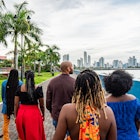
Dec 23, 2023 • 6 min read

Dec 20, 2023 • 6 min read

Dec 15, 2023 • 7 min read

Internacional
Hotel fairfield inn by marriott sabaneta, finca hotel mirador de la esperanza, hotel ghl grand villavicencio, hotel nana villeta, hotel four points sheraton medellín, hotel summer c, tequendama hotel campestre villavicencio, hotel san luis beach, hotel koray, hotel isla bonita, hotel tequendama suites, phoenix arizona, balí indonesia, fin de semana inolvidable 2 noches 3 dias rancho tota en pareja, refugio rancho tota, hotel tocarema girardot, hilton garden inn santa marta, hilton garden inn barranquilla, hilton bogotá calle 72, hilton bogotá corferias, hotel hacienda combia, hotel nq orinoquía, ac hotel santa marta, hotel spirito by spiwak cali, hotel radisson cartagena, cabo san lucas, kissimmee – orlando, holiday inn express, sonesta hotel pereira, hotel arbóreo, hotel bogotá plaza, mercure santa marta, sonesta valledupar, portón medellín, ghl el puente girardot, hotel spiwak cali, hotel waya guajira, casa fundadores, crowne plaza barranquilla, grand hyatt bogotá, sonesta cartagena, sonesta ibagué.

Debe completar todos los campos del formulario.
or with email

18 Reasons You Need to Travel to Colombia in 2024
Updated September 6, 2023
Safer than ever and brimming with incredible things to see and experience, Colombia belongs at the top of your travel bucket list. Don’t believe us? Here are 18 reasons you need to travel to Colombia ASAP. Any questions after reading? Message us!
#1: Colombia has never been safer
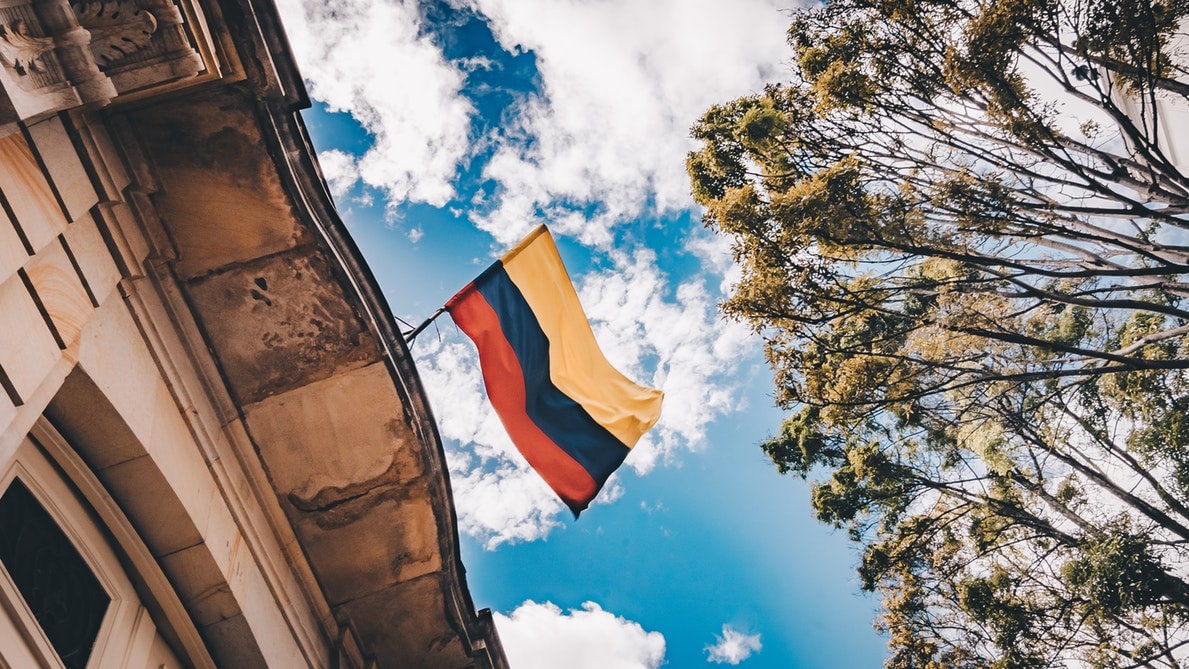
As with any international destination, petty theft (like pickpocketing) is still a concern, but it’s not unique to Colombia.
#2: The cities are simply incredible
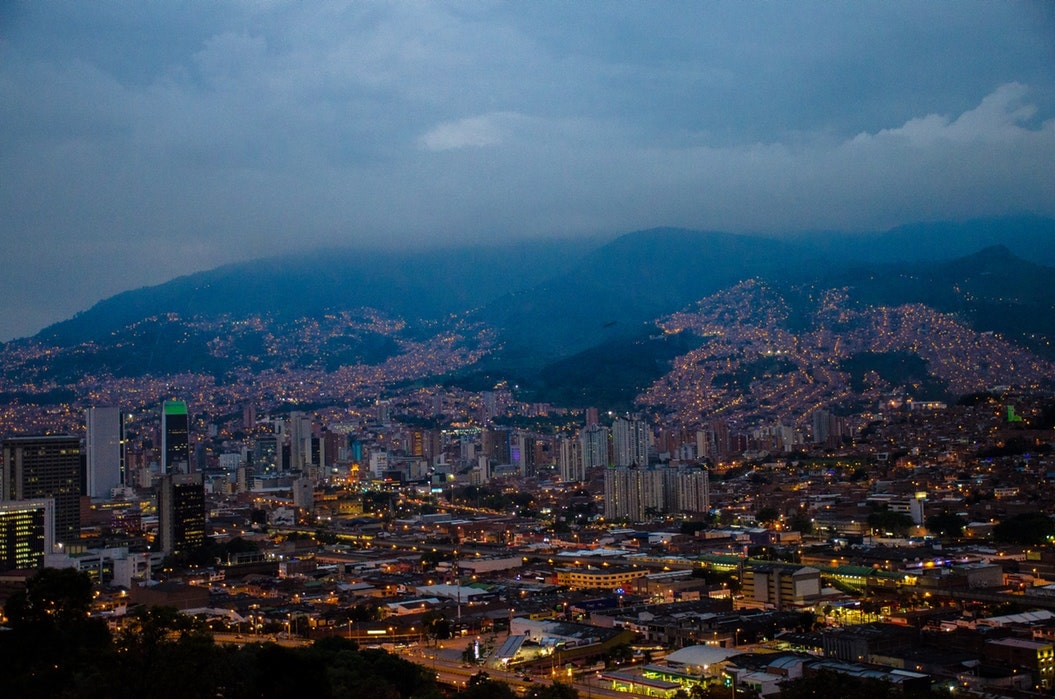
#3: Colombian coffee is some of the world's best

Pro tip: We’d recommend heading to the town of Salento to experience the Coffee Triangle in all of its stunning glory.
#4: Flights to Colombia are super cheap

Pro tip: Airports in the southern U.S. (think Miami, Houston, Dallas) usually have the best prices on nonstop flights to Colombia; the same flights from NYC or Newark can be up to $200 more expensive. If you live in the northern U.S., think about flying domestically to a major southern US hub, then continuing to Colombia.
#5: U.S. citizens only need a passport (no visas or travel applications are necessary)
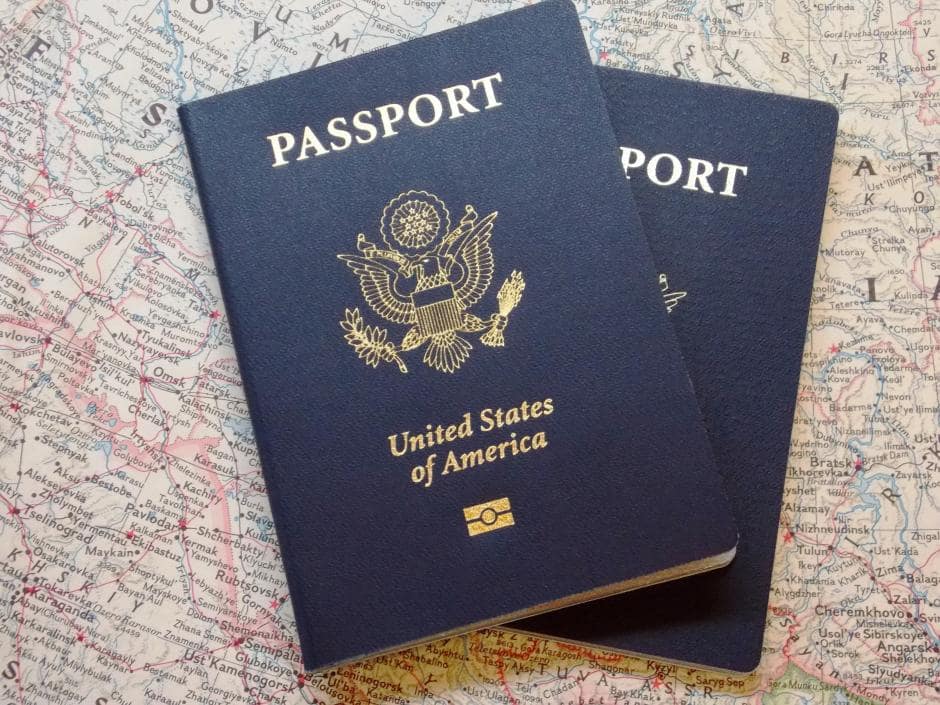
Pro tip: Remember to make a photocopy of your passport to keep with you, just to be on the safe side if the original gets lost.
#6: The exchange rate is fantastic
Since $1 USD is equal to 4000 Colombian pesos, it’s unbelievably easy to live the high life while helping Colombia’s local businesses flourish. That said, if you want to withdraw pesos on your trip, use ATMs at the airport or well-known local banks (Citibank, Banco Popular). Colombia is super safe for Americans, but has its share of scams which can be avoided by using licensed bank ATMs and limiting the amount of cash you carry.
Pro tip: Even if you’re only traveling to Colombia for 10 days or fewer, make sure to let your credit/debit card provider know the dates you’ll be away (otherwise, you’ll have issues with fraud prevention. Take it from us.)
#7: Colombian museums are one-of-a-kind

#8: Colombia's natural wonders will take your breath away

Pro tip: Make a list of the top 8 Colombian natural wonders you want to visit, prioritizing what you’re drawn to over what the guidebooks tell you, and setting your own pace to avoid travel stress.
#9: Colombians are known for their welcoming and hospitable culture
Even in Medellin or Bogota (which are pretty darn big cities), foreign travelers are often wowed by Colombia’s super-friendly atmosphere.
#10: The nightlife scene will turn you into a night owl

Pro tip: If you have concerns about navigating major cities at night, you can use Uber in Colombia to get safely to and from your hotel.
#11: Colombian cuisine will set the standard for tasty food forever
Colombia’s mouth-watering food is about to blow your mind. Whether you’re spending a weekend traveling Colombia solo or visiting for two weeks or more, you can’t miss trying out the amazing regional specialties. Even the pickiest eaters will easily find new favorite dishes, from bandeja paisa (a smorgasbord of beans and meats) to ajiaco (hearty chicken and potato soup). And since Colombia borders the Pacific Ocean and the Caribbean Sea, you’ll also have your pick of incredible seafood.
#12: The festivals are off-the-charts fun
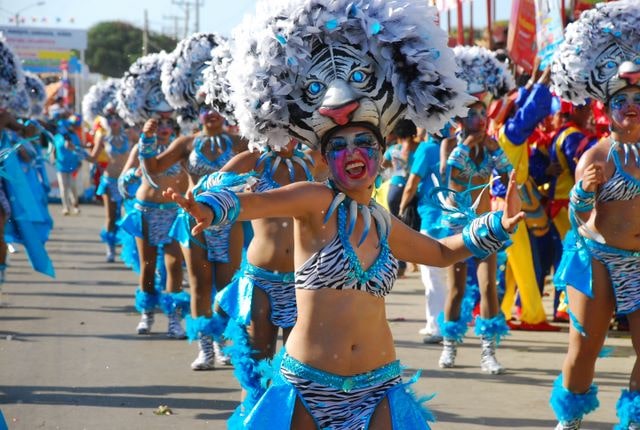
With highlights like the Barranquilla Carnival and dozens of amazing music festivals, Colombia’s year-round festival schedule provides endless opportunities for fun, no matter when you go. Festivals are ideal for meeting new people and immersing yourself in Colombian culture, as well as giving you a brand-new look at major destinations. For example, if you add Medellin to your itinerary, you can’t miss the Medellin Flower Festival (a week-long showcase of color, parties, and parades).
#13: Colombian street art is unparalleled

Pro tip: While Medellin is very safe for travelers, Comuna 13 can still get sketchy.
#14: The country’s public transportation is easy to navigate
Trams, buses, and metros, oh my! With a plethora of affordable public transport options, getting to Colombia’s highlights is very easy. Metro tickets in Medellin run at a whopping 79 cents, and trams and buses throughout Colombia’s cities run at similar fares, averaging $1 per ride.
Pro tip: If you’re willing to spend 2–4 more hours in travel time, using public transportation is a fantastic way to save money on day trips from Bogota or Cartagena.
#15: Colombia is great for solo female travelers
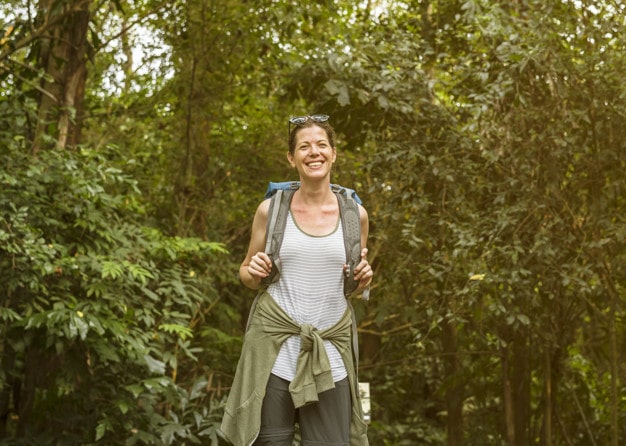
Colombia checks off all the boxes for solo female travelers — it’s affordable (Airbnb apartments go for $20 – $50 a night), it’s accessible (especially by cheap cross-country flights), and above all, it’s safe. While catcalling does occur, it’s no worse than anywhere else in Latin America.
#17: You don’t need to know Spanish to get around easily
In major cities, most Colombians you’ll meet will know at least a few English phrases. The farther you get into the countryside, the fewer people speak English. Don’t let language differences deter you — many of Colombia’s most amazing sights are found in mainly Spanish-speaking locales like Barranquilla or Cali!
Pro tip: Knowing a few key Spanish words can help you navigate and make friends, and locals recognize and appreciate your efforts.
#18: Incredible activities are budget-friendly

Pro tip: Staying in a major hub like Bogota or Medellin but short on time? There are tons of amazing things to do within the city limits.

Leave a comment:

Select Account Type
Sign-up with
Almost there!
Find booking.
Promotional Title
How should we contact you?
Thank you! We'll get back to you as soon as possible!
Click to register and track your question !
If you would like to follow up with us:
+1 (855) 782-3006
Forgot your password?
Enter your email address below and we'll send you a reset link:

Diners Travel

Por más de 41 años, somos la Agencia de Viajes líder en el Mercado Peruano , comprometida en el diseño y planificación de viajes a la medida de cada uno de nuestros clientes; haciendo de sus viajes corporativos y vacacionales, una experiencia única e inolvidable.
Contamos con el respaldo de " Diners Club Perú ", ambas empresas somos parte del "Grupo Egas" / "Banco de Pichincha" (Ecuador).
Nuestro equipo profesional altamente calificado, con un promedio de 15 años de experiencia, es constantemente entrenado y motivado, compartiendo una pasión que se puede sentir en la forma en que aplicamos nuestros conocimientos y recursos, para proporcionar un valor tangible a nuestros clientes.
"¡Somos un equipo que va más allá!"
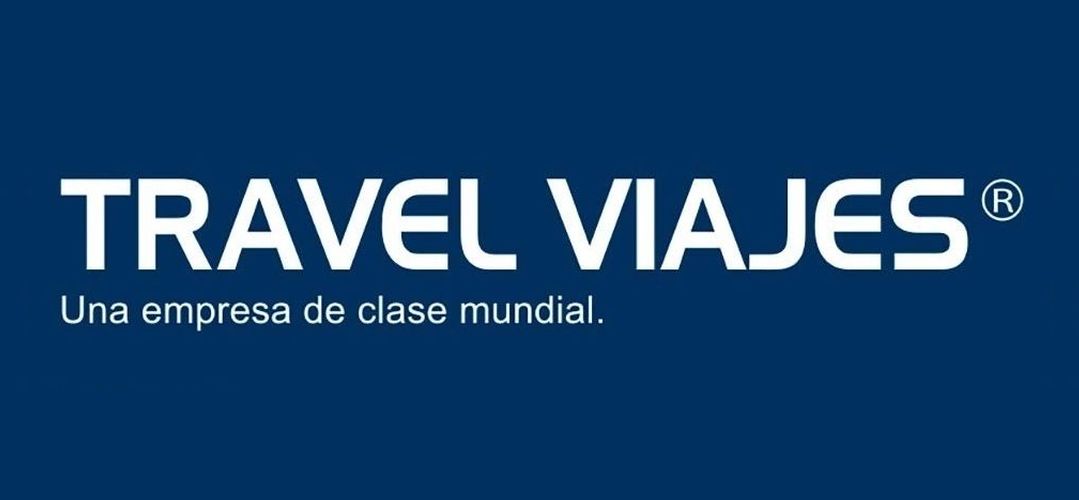
Travel Viajes Mexico
Travel viajes colombia, travel viajes usa.

IMAGES
VIDEO
COMMENTS
Privilegios Davivienda en viajes, le permite acceder a un amplio número de beneficios, que hemos preparado para usted, entre los que se encuentran: • Buscador de hoteles, renta de autos y venta de tiquetes aéreos. • Entradas a parques temáticos y espectáculos. • Posibilidad de hacer upgrade (servicio de mayor categoría) de ...
BIENVENIDO. ¿Ya conoce las experiencias que tenemos diseñadas para usted por pertenecer a Privilegios Davivienda? VER MÁS. Banco Davivienda S.A. Todos los derechos reservados 2024. Viva inolvidables momentos alrededor de la gastronomía en los mejores y más reconocidos restaurantes, y disfrute exclusivos beneficios en viajes.
Check in: 15:00 Check out: 12:00 AC Hoteles Marriott con ubicación privilegiada, a pocos minutos caminando de lugares de interés como: la Bahía, la Marina y del Centro Histórico de la ciudad de Santa Marta, podrá disfrutar de un paseo relajante por la playa, deleitarse con un atardecer mágico. La propiedad tiene un enfoque de Forma […]
para usted. Principales. Amparadas. Diners Club es el medio de pago inteligente para personas como usted, quienes más que una forma de pago, desean un excelente servicio. Además de ser una tarjeta, es el pasaporte de entrada a un mundo de privilegios diseñados especialmente para usted.
Diners Club Airport Lounges. Enter city or airport. Feel like you've already arrived with access to more than 1,500 airport lounges and experiences near and far. It's one of the many benefits available exclusively to Clubmembers. For more personalized and up-to-date information, download the Diners Club Travel Tools mobile app.
Some of Colombia's vegetarian diners feature on the international listing www.happycow.net. Entries also state if the menu is vegan, lacto, organic, eat-in or take-away. Health and safety in Colombia Health. Healthcare in Colombia is reasonably good, especially in cities where getting modern medical treatment fairly fast poses little problem.
Stick to exploring one section of the country and exploring it well: spend three weeks bouncing between sun-soaked, Caribbean beaches or heading from Medellín deep into the Zona Cafetera. Your trip should match Colombia's characteristic pace: slow and enjoyable. 2. Domestic flights are affordable and quick.
Líneas de Atención. Bogota (601) 338 3838; resto del país; 018000 123 838; Desde Estados Unidos; 833 95 73443; Desde España; 00 8000 3383838; o a través de nuestro Chat ingresando por la opción "necesita ayuda"
1. Re: Is diners club international or discover accepted in bogota. Yes Diners Club has a presence in Colombia however some smaller restaurants and stores insist on cash transactions.Both Bogota and Cartagena are major tourists destinations;many establishments accept a wide array of credit cards.If you plan to use your card for major purchases ...
Colombia 3-Week Itinerary: The Ultimate 2024 Travel Guide. South America. colombia. Discover the unexpected in extraordinary Colombia! In a country of two sides, expect to find steel skyscrapers bordering colorful pueblos, beaches backing onto snow-capped mountains, and dense green jungle merging into red deserts.
Use this Colombia travel guide and the following Colombia travel blog post to plan your perfect vacation. The top destinations in Colombia are Cartagena, Medellin, and Bogotá. ... American Express and Diners Club may be accepted. Remember to notify your bank that you will be traveling to Colombia. Save money on fees with a credit card that ...
The U.S. government has limited ability to provide emergency services to U.S. citizens as U.S. government-personnel travel to these areas is severely restricted due to security concerns. Colombia - Venezuela Border - Level 4: Do Not Travel. U.S. citizens are advised not to travel to the border of Colombia and Venezuela.
Buses are Colombia's main means of transportation, and they are incredibly cheap and safe. Taxis, on the other hand, are also cheap, but a few inconveniences come with them. First, they can be ...
Benefits. Live life to the fullest with distinctive benefits for Clubmembers. Privileges and offers to enhance your shopping, dining, travel and hotel stays. Acceptance. Discover a world of opportunity with acceptance at more than 55 million merchants. Based on data provided to Diners Club International by merchants, acquiring institutions and ...
PRIVILEGIO WEEK VACATION. Disfrute de un merecido descanso para usted y un acompañante, con una semana de alojamiento de 5 a 7 noches, según el hotel aliado, desde 300 dólares, en destinos internacionales seleccionados. Aplica para clientes con un mínimo de permanencia de 6 meses en el programa. MÁS INFORMACIÓN.
One week in Colombia itinerary Medellin - Guatape - Jardin - Salento . There is so much to see and do in Colombia; however, for me, the area around Medellin is the absolute highlight.. This Colombia travel itinerary couples the country's most interesting city with the coffee-growing mountains around Salento and Jardin.. If you are looking for a Colombia itinerary to help you explore ...
La afiliación del comercio a la franquicia Diners Club, es la figura que le permite a un establecimiento hacer ventas de productos o servicios a los tarjetahabientes Diners aceptando la tarjeta como medio de pago. Al comercio se le cobrará un porcentaje sobre las ventas (comisión) la cual es pactada con el cliente.
The higher you go, the colder it tends to be. Here's a rough guide of the average temperatures depending on altitude: < 1000 m - More than 24°C (Cartagena, Santa Marta, Cali) 1000 - 2000 m - ~ 20°C (Medellín, Manizales) 2000 - 3000 m - ~ 14°C - (Bogota, Pasto) Colombia has two seasons, a wet and a dry one.
December to February is ideal for hiking Colombia's national parks. December to February is a fantastic time to travel through Colombia because it's dry everywhere except the Amazon. In the Andes, expect sunny skies and warmish days - perfect for hiking in the country's clutch of outstanding national parks, while the Caribbean coast is at ...
Hilton Bogotá Calle 72. Check in: 03:00 pm Check out: 12:00 pm Hotel Hilton se encuentra ubicado en el distrito financiero en el norte de Bogotá. Esta a dos kilómetros de Zona Rosa, donde se encuentran la vida nocturna, las tiendas y los restaurantes más exclusivos de la ciudad. El hotel cuenta con acceso al gimnasio , piscina climatizada […]
April 19, 2019Solo travel to Colombia can seem intimidating — but the truth is, the country's amazing culture, warm locals, and modern attitude make it a fantastic place to visit by yourself.With that in mind, we've created this guide to solo travel to Colombia, complete with recs on where to visit and how to stay safe, tips for solo female travelers, a comparison of lodging options, and ...
Updated September 6, 2023Safer than ever and brimming with incredible things to see and experience, Colombia belongs at the top of your travel bucket list. Don't believe us? Here are 18 reasons you need to travel to Colombia ASAP. Any questions after reading? Message us!#1: Colombia has never been saferThe word is out — Colombia is super safe for travelers. Since the end of the civil war ...
Contamos con el respaldo de "Diners Club Per ... Diners Travel en: Contáctanos: +51 (1) 615 1132, 615 1132 Av La Encalada 932, Surco, Lima 15023, Perú ... Travel Viajes Colombia.